Open House and Dedication
Richard O. Cowan, "Open House and Dedication" in A Beacon on A Hill: The Los Angeles Temple (Religious Studies Center, Brigham Young University; Salt Lake City: Deseret Book, 2018), 119–162.
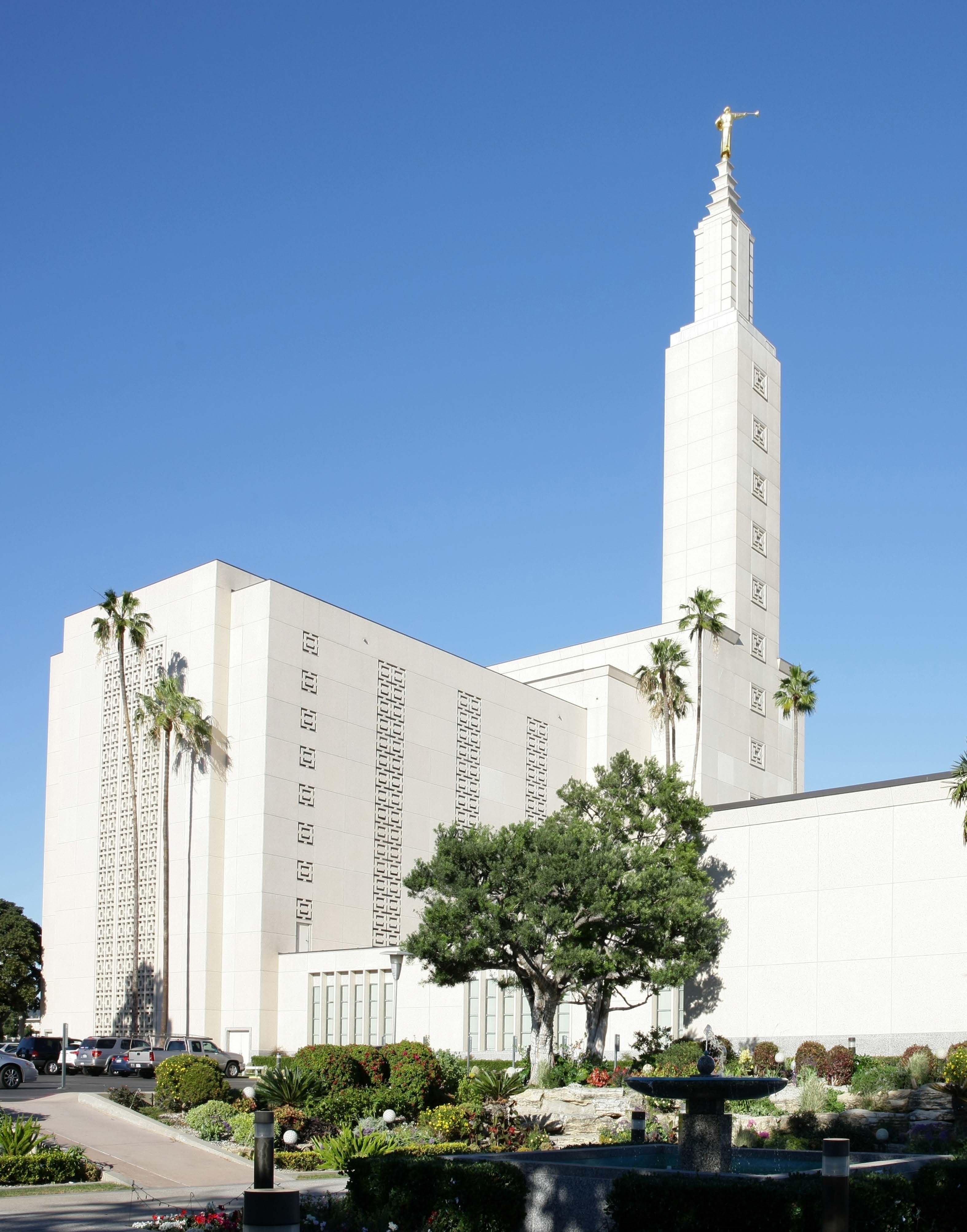
1955 Bureau of information begins receiving visitors (spring)
First outside group tours temple (November 11)
Two thousand Church leaders meet in upper assembly room then tour temple (November 25)
Open house begins (December 19)
1956 Open house concludes after 662,631 had visited (February 18)
Hour-long television program features new temple (March 4)
Temple is dedicated by Pres. David O. McKay (March 11–14)
Even before the Los Angeles Temple was completed, it attracted widespread attention. Southern California Latter-day Saints were especially interested in following the progress of construction. At this time, when security and liability concerns were not as intense as in later decades, individuals or small groups were able to walk onto the site to get a closer look. The Los Angeles Stake, within whose boundaries the temple was located, sponsored at least two organized group tours. In April 1953 the stake high priests quorum visited the temple. Then, in October of that same year, stake conference was held in the newly completed Westwood Ward building on the temple site; between the morning and afternoon sessions, President John M. Russon led nearly a thousand stake members on a tour through the temple’s shell.[1] On March 19, 1955, President A. George Raymond of the Logan Temple addressed five hundred Southern California seminary graduates on temple marriage; they then toured the temple grounds and held a testimony meeting in the Westwood Ward chapel as part of their “Day of Spiritual Activities.”[2]
Interest was not confined to Church members. Temple architect Edward O. Anderson reported that he received compliments from fellow architects. After a professor of architecture at the University of Southern California had visited the temple, he affirmed: “I gained the definite impression that architecturally speaking, the Los Angeles Mormon Temple has a quality of timelessness, reflecting the great architectural expressions which come down to us through all the ages in religious experience.” Another, an authority on Jewish synagogues, stated that the building’s design “has great solidity and still has grace and delicacy.”[3]
On June 29, 1953, the Los Angeles Examiner, the city’s second largest newspaper with a circulation of 200,000, published a full-page article featuring the new temple. Written by Stanley Dunn, it was illustrated with six photographs. “Friendly in its approach, the article was factual and interesting in its treatment of the construction of the great Los Angeles Temple.”[4] Just over two and a half months later, another article on the temple appeared—this time in the September issue of Southwest Builder and Contractor, the largest building trade magazine in California, Arizona, and Nevada. The three-and-a-half-page article, written by Harold K. Hensley, was illustrated by seven photographs. “The immensity of the structure,” Hensley asserted, “can be understood only by visiting the site, which commands a sweeping view in all directions of the Los Angeles metropolitan area. It is already quite apparent that nothing more impressive has ever been built in Southern California.”[5] Later, another trade magazine, Electrical West, again featured the temple. “Both for exterior floodlighting and for the individual lighting effects in the halls within the temple, many unusual lighting techniques were employed.” Seen from throughout the western part of Los Angeles, the floodlit temple and tower “are an outstanding architectural monument in that area of the city.” The article then described how primarily indirect lighting enhanced the murals in the temple’s main rooms.[6]
Los Angeles Temple Mission and the Bureau of Information
This positive attention from the press stimulated even more interest in the temple. Motorists driving along Santa Monica Boulevard reported that “they were so startled and impressed with the magnitude and beauty of the building and grounds that they could not resist stopping to inquire about the temple.”[7] Thousands began visiting the site, a large number of whom were not Latter-day Saints. President Stephen L Richards, First Counselor in the First Presidency, was convinced that the magnificent temple constituted “a great missionary force.” He believed it “epitomizes perhaps the most distinctive phase of the message which we have to give the people of this world”—that the gospel offers salvation to all, including those who died without the opportunity of even hearing about Jesus Christ. Visitors would be prompted to ask: “Who is it that builds a temple of this kind? What is it for?”[8] Elder Bruce R. McConkie of the Seventy similarly affirmed that “the current construction of the Los Angeles Temple is attracting much attention” and is “causing many to investigate the Gospel.” Furthermore, he insisted, “the caliber of the converts gained is of high order.”[9]
With this missionary potential in mind, Church leaders created the Los Angeles Temple Mission with knowledgeable volunteers who conducted guided tours safely around the building site, allowing construction to go forward uninterrupted. In December 1954, Frederick S. Williams was named president of this mission and director of the bureau of information. Born in the Mormon colonies of northern Mexico, he served as missionary and mission president in Argentina. He then became involved in international business and lived in South America. He was called to open the mission in Uruguay in 1947. At the time of his Los Angeles Temple Mission appointment, Williams was living in the southeastern suburb of Downy.[10] About a year later, he was succeeded by A. Merlin Steed, a prominent Southern California businessman. Born in Utah, Steed became involved in livestock raising in southern Alberta, Canada, before moving to California. He established his home in Glendale and served in the presidencies of the Pasadena and San Fernando Stakes. President Steed had served as director of the visitors’ center at the Hill Cumorah in New York for two years when he received his assignment in Los Angeles. Because his appointment came at the time of the temple’s open house, his responsibilities were immense. He therefore was given two counselors, Raymond A. Summers, former bishop of the Pasadena Ward, and Guy B. Rose, who had presided over the New York Stake.[11]
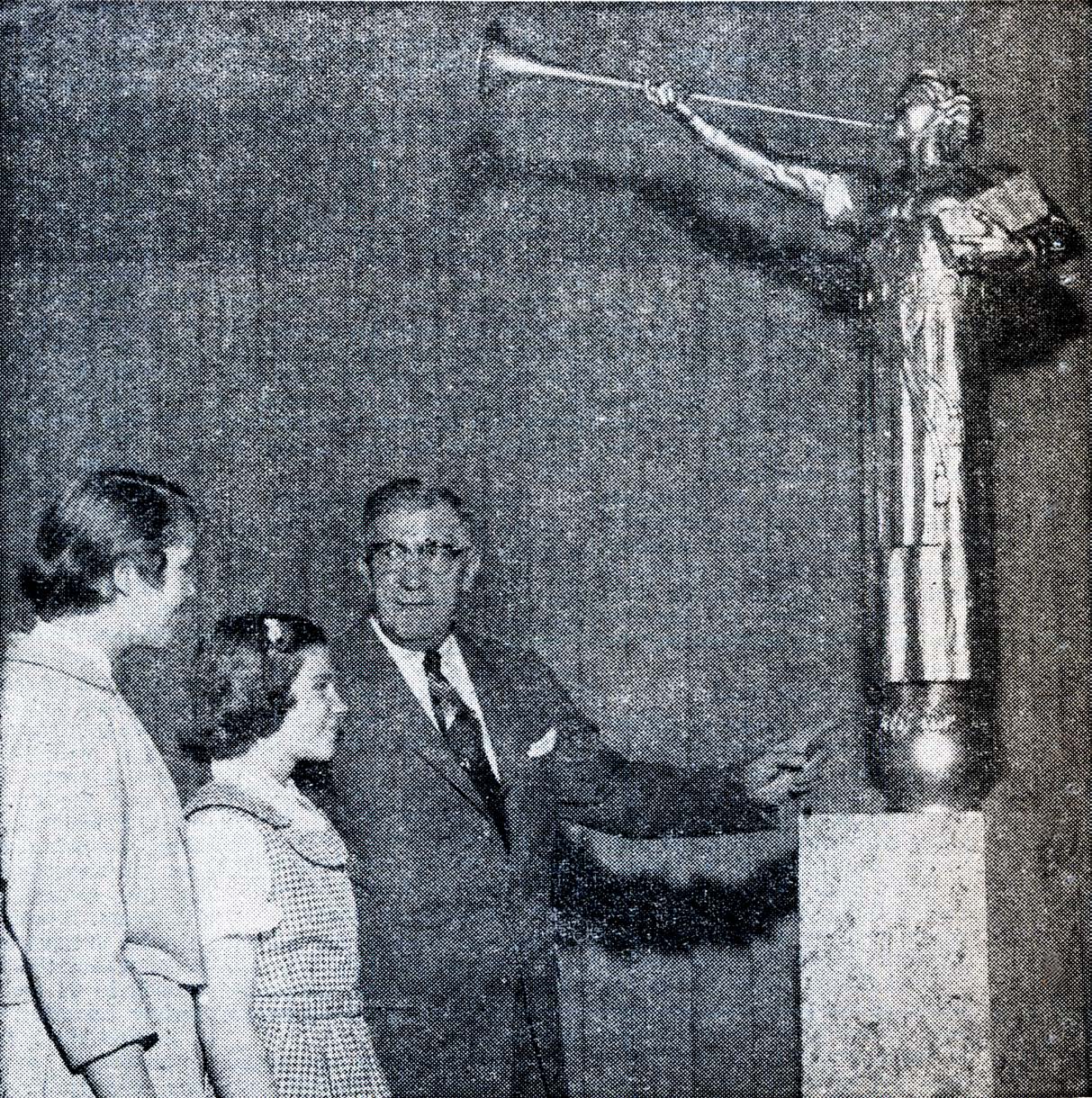
As soon as the bureau of information or visitors’ center building was sufficiently completed in the spring of 1955, it began receiving interested guests. It was open daytime and evenings and was staffed with missionaries prepared to tell visitors about the “message of Mormonism,” the purpose of temples, and the story of the Los Angeles Temple’s construction as they guided groups around the site. On each side of the bureau’s spacious lobby, large exhibit halls featured pictures, charts, and other visual materials explaining the restored gospel and the role of temples. In addition to the artists’ original sketches of the temple murals, models of the angel Moroni statue and baptismal font became popular exhibits. This building became the headquarters of the temple mission and thus included the office for the mission president, who also served as the bureau’s director.
At first, there were only a few visitors each day, but this total quickly increased to hundreds. By summer, the daily number registering at the bureau on Saturdays and Sundays was well over a thousand. The temple had become such a landmark that it was a “Mecca” increasingly attracting interested people who were not Latter-day Saints. They came from all parts of California as well as from throughout Canada, the United States, Mexico, and abroad. The number of volunteer hosts reached 125.[12]
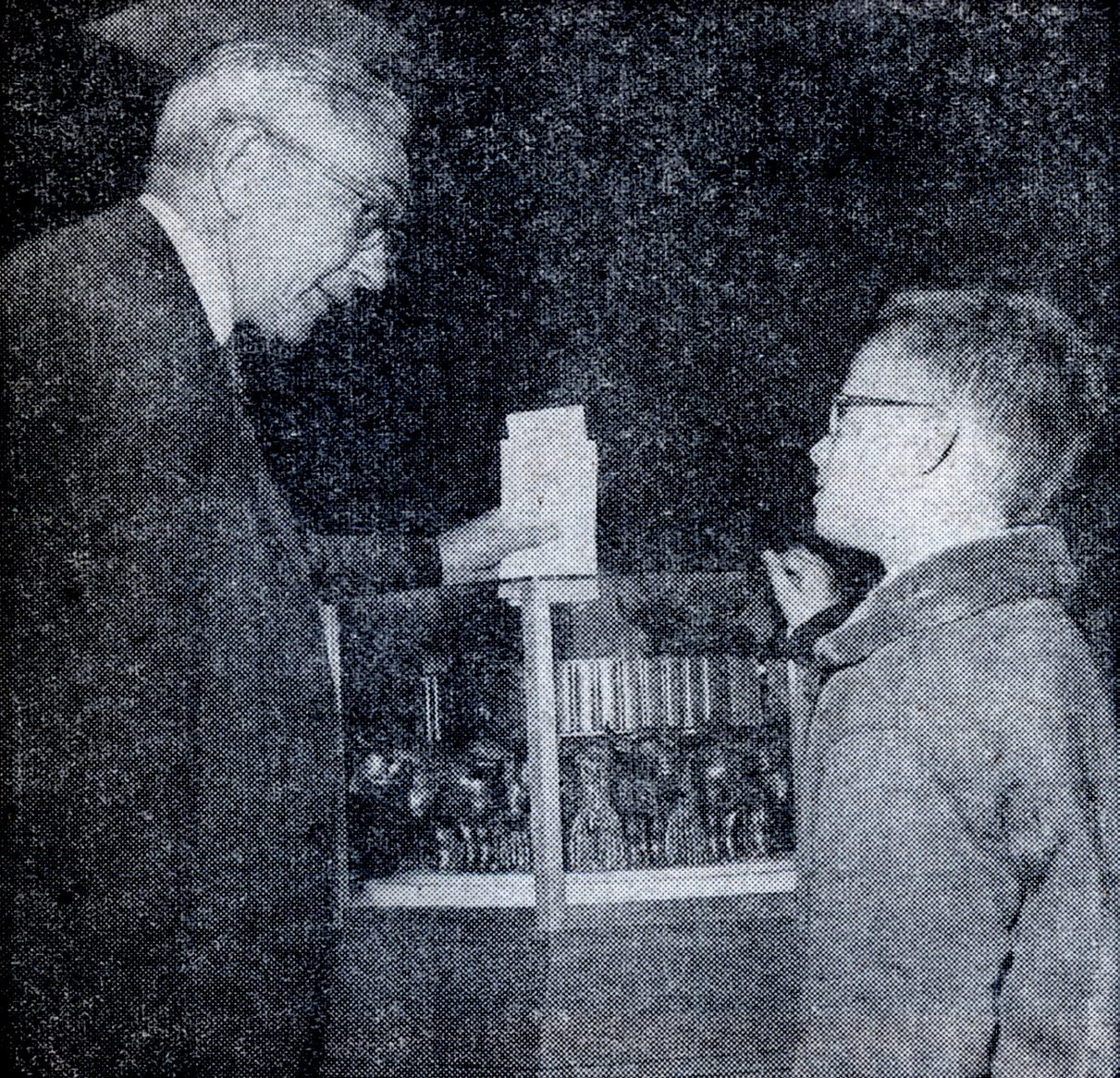 Early exhibits in the bureau of information. (Church News)
Early exhibits in the bureau of information. (Church News)
These visits often sparked sincere interest. On one occasion, President Williams explained the plan of salvation and the role of temples in it to a New Zealand visitor and her American friend. After the two had been left alone for a few moments, they again approached President Williams, and the American woman said: “What you have been telling us gives us goose pimples. It is so different from anything we have ever heard before. My friend . . . says she is going to join your church.” “Yes,” the New Zealand woman responded, “This is so much greater than anything we have ever heard. I would be interested in having the missionaries to call on me in New Zealand so that we might learn [more].”
After a Jewish woman had visited the temple in Los Angeles, she and her family visited Temple Square when they were in Salt Lake City. As the guide was giving information about the Salt Lake Temple, the woman’s nine-year-old son spoke up and said: “Yes, but you should see our temple in Los Angeles. It’s bigger and prettier than this one, and it has 90 rooms in it!” A noted Jewish architect from New York City walked around the Los Angeles Temple “studying it minutely from every angle.” He then explained how he had traveled all over the world and asserted: “I want you to know that this is the most beautiful building in the world. I feel as if I were standing on sacred ground.”[13]
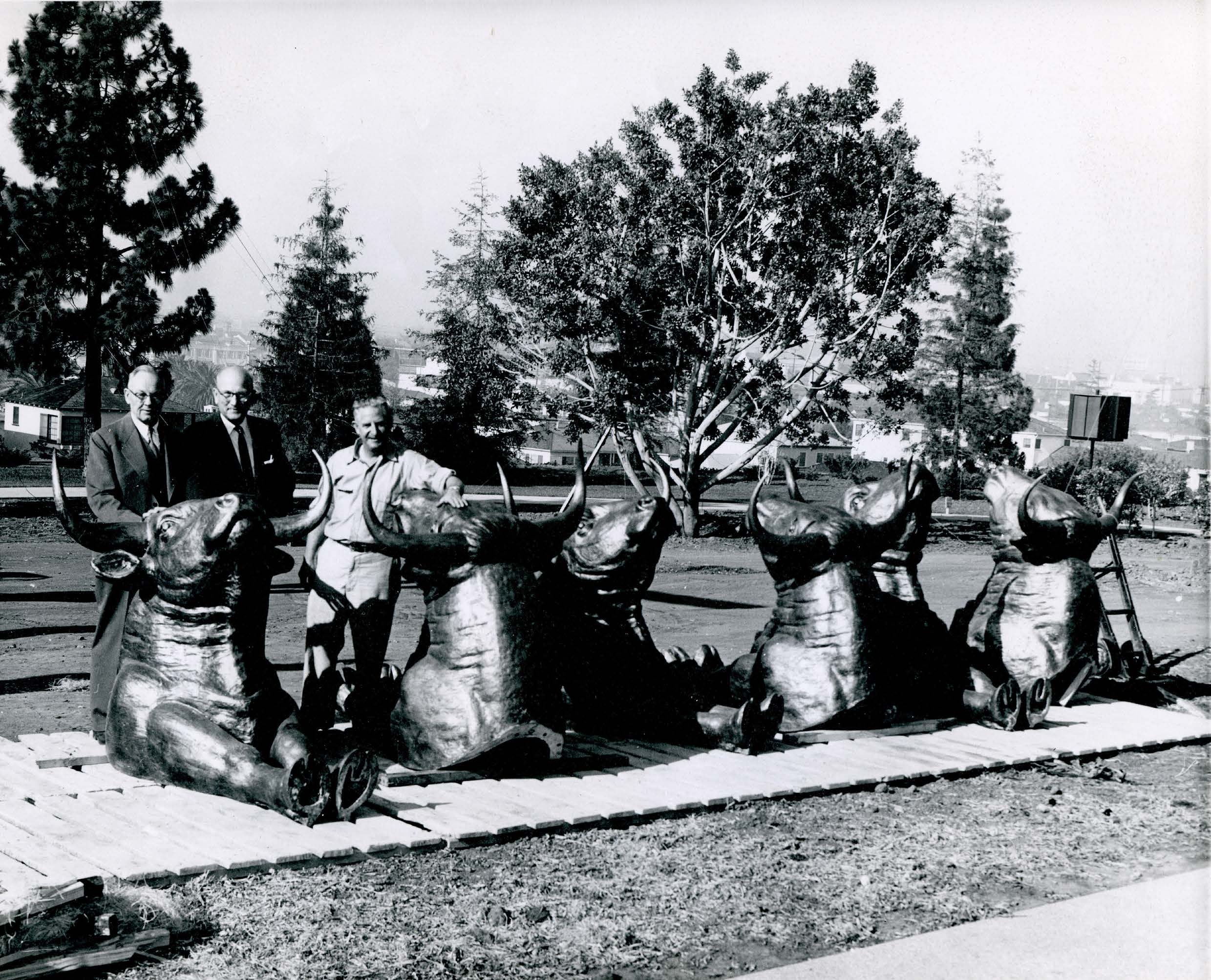 Oxen being delivered,
Oxen being delivered,
November 1955. (Los Angeles Temple Historical Scrapbook [Scrapbook])
A New York businessman wanted to know when the open house would be so he could time his next business trip to allow him to attend.[14]
Along with the many serious inquiries about the Church and its temple, guides received some rather humorous comments. Frederick S. Williams reported that one well-dressed woman asked if it was the angel Gabriel on top of the temple. When told it was the angel Moroni she replied that her husband had said there were only two individuals who could blow a horn like that, the angel Gabriel and Louis Armstrong, and she was sure it wasn’t Louis Armstrong. A man upon seeing the reflection pool at the front of the temple wanted to know if all the neighbors would be permitted to use the swimming pool or if it would be restricted only to members of the church.[15]
The Open House
In July 1955 the editor of the Church News reported that the temple was nearly completed and that its dedication would probably take place early in December. Plans were already being made for the formal open house, which likely would start in September. Among the myriad of construction tasks to be completed first were two major projects. The temple’s baptismal font on the backs of twelve oxen was expected to be in place by the first week of August, and completion of the large murals in the temple’s ordinance rooms was anticipated by the end of summer.[16] Edward Grigware, however, did not put the finishing touches on his garden room mural until early November. Furthermore, the first six of the twelve oxen were not received until the fourth of that month, and the other six were expected two weeks later. A natural disaster was the cause of this delay. When two of the bronze oxen were being cast in the Roman Bronze Company ovens in New York, floods resulting from an East Coast hurricane interrupted power so the kilns had to be shut down and the oxen recast later. Finally, they were completed and could be shipped by truck across the continent to the temple. The architect and contractor inspected the oxen upon their delivery and gratefully found that they had arrived in perfect condition. Each of the oxen weighed 600 pounds, was 5 feet high, and measured 4 feet and 4 inches from horn to horn. They had to be lifted from the trucks by means of a heavy-duty hoist and then carefully maneuvered over wooden runners into the temple and down to the baptistry. With these tasks finally completed, dedication was officially scheduled for March 11, 1956, with the open house to begin about three months beforehand on December 19, 1955.[17]
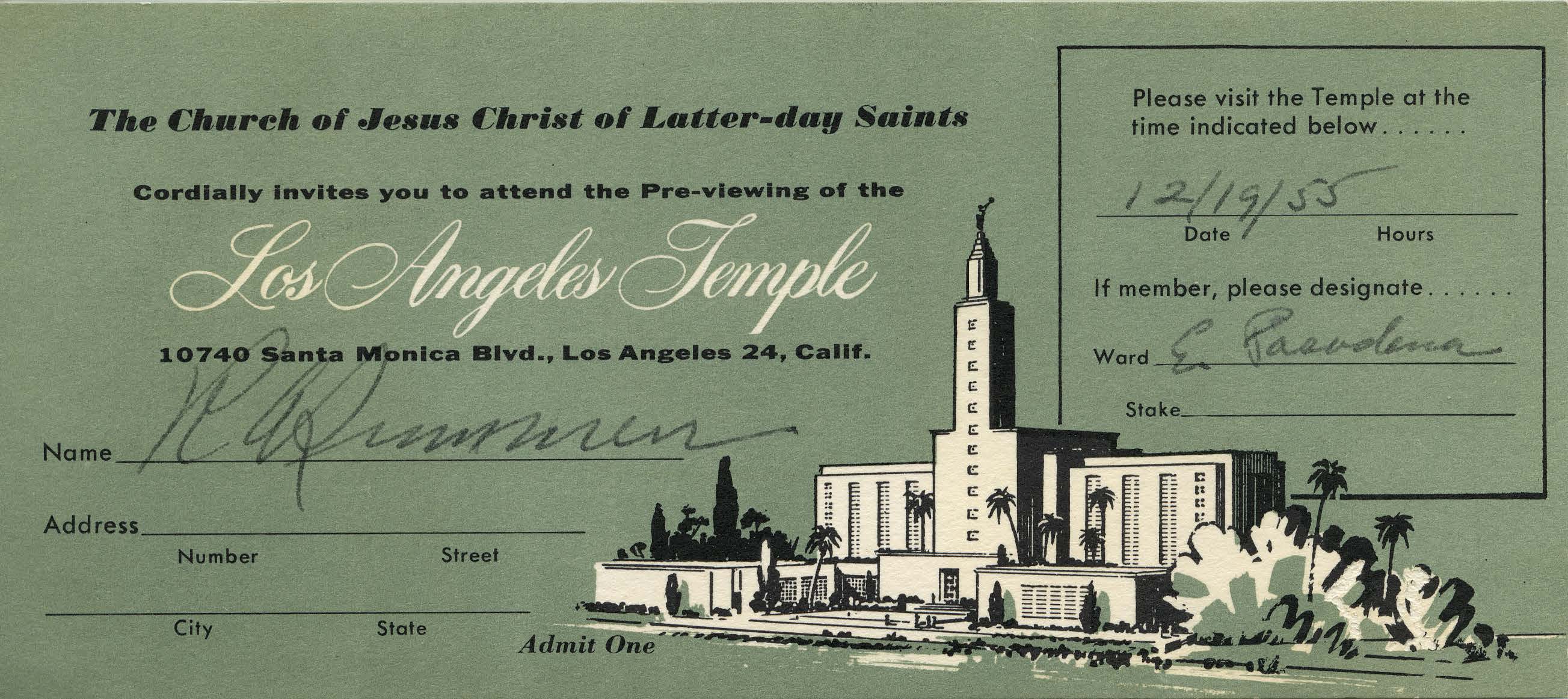 Open house invitation. (Scrapbook)
Open house invitation. (Scrapbook)
In October 1955 the Southern California stake presidents, now numbering seventeen, and their wives were taken through the nearly finished temple and invited to share their ideas about the open house. The first outside group toured the temple on November 11. This group, numbering about four hundred, included personal friends of Edward Grigware and members of two local Rotary Clubs. They gathered in the bureau of information and were divided into groups of twenty-five or thirty for the tour under the direction of Frederick S. Williams.[18]
Church leaders in Salt Lake City then called a special meeting for Friday, November 25. Invited were members of stake presidencies and high councils, ward bishoprics, clerks, and their wives. This group of Southern California leaders, numbering about twenty-five hundred, was to meet in the spacious assembly room on the temple’s third floor. Purposes of the meeting included giving these leaders an opportunity to visit the new temple, considering plans for gathering the remaining temple fund pledges, and providing a dry run for conducting multitudes through the temple during the open house, which would begin just three weeks later. This event was planned by the temple committee of four stake presidents—Noble Waite, South Los Angeles, chairman; Howard W. Hunter, Pasadena; John M. Russon, Los Angeles; and Hugh C. Smith, San Fernando—and Frederick S. Williams, president of the temple mission.[19] On the appointed day, there was bumper-to-bumper traffic for several blocks on the narrow residential streets approaching the temple entry gate through which only one car could pass at a time.
After the overflow group opened the meeting singing “Come, Come, Ye Saints,” President Noble Waite announced that $1,352,000 of the pledged $1,648,000 had already been contributed. The final push for funds would run from December 11 through March 1. Each president spoke briefly, committing his stake to meeting the goal. Four stakes had already reached their quotas, and six others were close. President E. Alan Pettit of the Bakersfield Stake reported that they lacked only $570, which he thought he could collect from fellow stake leaders during their long drive home. President Waite spoke of an eighty-one-year-old widow in the Maywood Ward who paid her original pledge of $100, and then pledged another $100. She then pledged “another and another until she has now contributed $600.” He then invited this tiny white-haired lady, Sarah Lewis, to stand as an honored guest in this vast assembly of Church leaders. Architect Edward O. Anderson next explained that the temple was seven years in the making—three and a half to design and three and a half to build. “Never have I enjoyed anything so much,” he affirmed. The main speaker was A. Merlin Steed, newly appointed president of the temple mission under whose direction the throng afterward walked through the building. The leaders from each stake toured as a group, leaving at five-minute intervals, concluding at 11:00 p.m.[20]
The evening’s tour had been planned by Frederick S. Williams. He arranged for a knowledgeable person to be in each of the large ordinance rooms to answer questions. Assigned in the garden room was Edward Grigware who had just finished painting its mural. Williams suggested some points that should be covered but then left the artist free to add others if he wished. Toward the end of the evening, Williams went from room to room to be sure there were no delays. He found a bottleneck in the garden room. “Grigware had departed a great deal from the script and was expressing his feelings on what had happened to him during the 13 months he had painted there. He told of his great joy in painting in the Temple.” As the last group passed through, “he bore his testimony that the gospel was true.” When asked why he hadn’t joined the Church, he explained that his wife was a member of another faith and he didn’t want to break up his family. “She has never had the opportunity of painting a mural in a Mormon Temple or she would feel as I do now.” After the crowd had gone, Grigware signed the mural, “with tears in his eyes” took one last look at his beautiful work, handed Williams his key to the outside door, and then turned and left, realizing that he would likely never return.[21]
Appropriately, one of the first groups invited to visit the temple was the immediate family of Harold Lloyd, the motion picture actor from whom the Church had bought the site eighteen years earlier. After his visit on December 7, he wrote: “The temple is a thing of beauty and awe—dignity, reverence; and a sense of eternity. We found ourselves transported.” He expressed appreciation for “this never-to-be forgotten insight to a better life.”[22]
VIP tours were offered during the week prior to the beginning of the public open house. Governor and Mrs. Goodwin J. Knight flew down from Sacramento to visit the new temple; “shoes in hand,” they were escorted through the building on Tuesday, December 13, by A. Merlin Steed. Following their tour, they declared the temple to be “one of the most beautiful buildings we have ever seen.”[23] They were followed two days later by Mayor Norris Poulson and four members of the Los Angeles city council.” Over 2,000 toured the building on Saturday, including 407 Latter-day Saints from Fresno and the San Joaquin Valley. A junior genealogy group comprising 287 youth and their leaders from Mesa, Arizona, visited the temple after preparing two years for this experience.[24]
Invitations to visit the temple were issued on an allotment basis by ward bishops and branch presidents. {5A3} Each ticket indicated a date and time for the visit. Those arriving by automobile were directed to enter the grounds from the north on Ohio Ave by the Westwood Ward chapel. After the tour, they would leave to the southeast via Manning Ave. About 3,000 visited the temple on Monday, December 19, the first day of the open house. Tours commenced at 8:00 a.m. and continued until 8:00 p.m., Monday through Saturday. The grounds and bureau of information were closed on Sunday during the open house period.[25]
The press, both local and national, noted with interest the commencement of the temple’s open house tours. Writing in the Los Angeles Herald Express, Edward Prendergast reported that “by day and night, the huge new West Los Angeles temple of the Mormons has intrigued the curiosity” of area residents and passersby. He asserted that visiting the building would show the error of some fabulous tales that had been circulating about it. The “great pool in the basement” was the ten-foot baptismal font on the backs of twelve oxen as at Solomon’s temple. Dead bodies are not brought into the temple; the Mormons believe in baptism for the dead, not baptism of the dead. In response to questions from many children, temple officials indicated that Moroni’s trumpet “will not blow.” The writer then described some of the temple’s features, including “the great assembly room, as big as a football field.” For him, “the heart of the temple” were “five dramatically muraled chambers depicting in flaming colors or in calm repose man’s steppingstones through this world to heaven.” The “exquisitely decorated” celestial room “with delicate pastel shades and dim tracings” depicted a “far-off paradise” and “bliss in the world to come.”[26] In like spirit, Time Magazine in its January 16, 1956, issue declared that “one of the biggest tourist attractions in California is the Mormon temple.” Calling it “the temple of the five rooms,” Time described it as “the largest and most magnificent of the ten Mormon temples in the world.”[27]
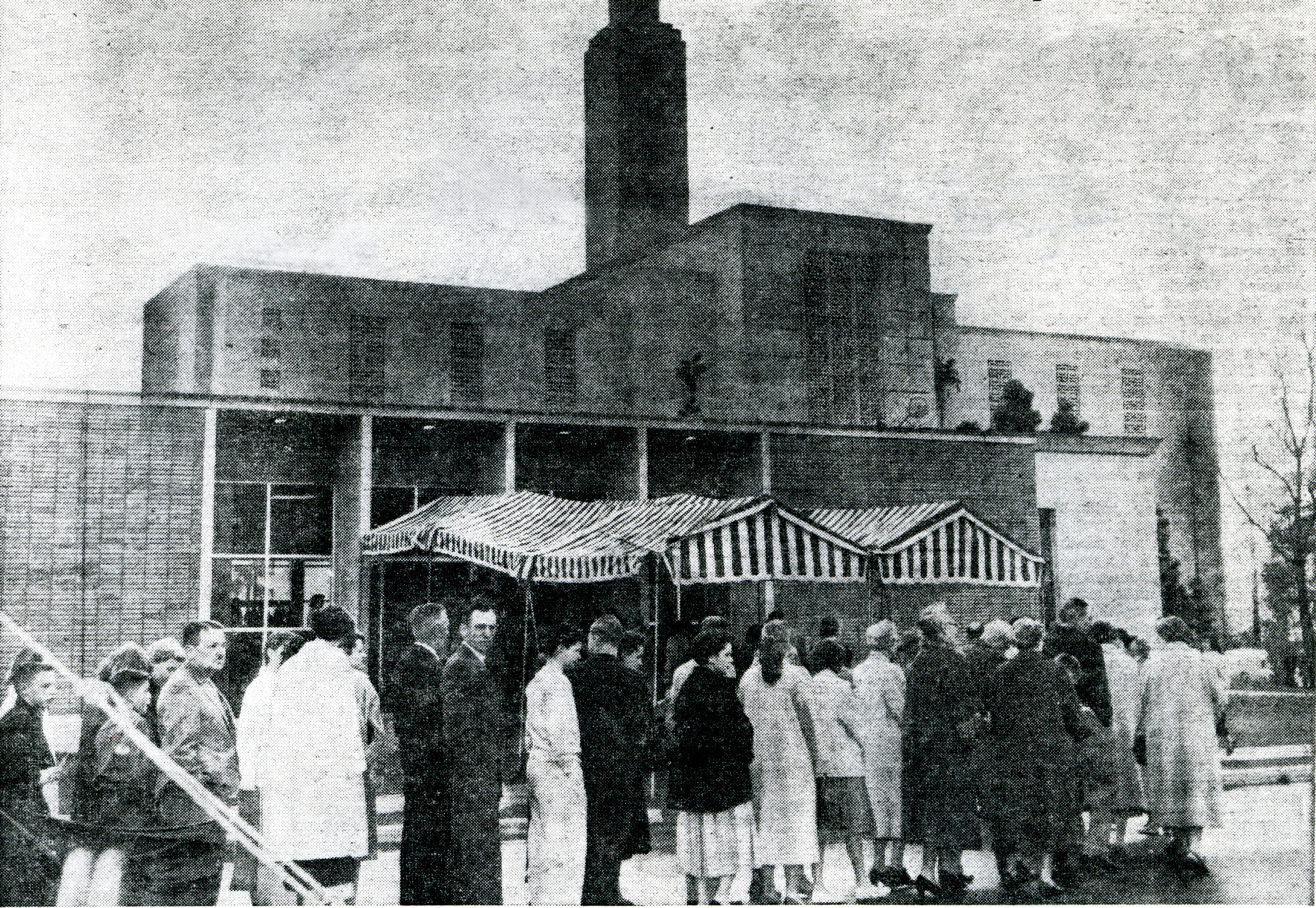 The open house tour began in the bureau of information. (Courtesy of John Carmack)
The open house tour began in the bureau of information. (Courtesy of John Carmack)
Tours lasted about forty-five minutes. They began in the bureau of information, where visitors first heard a brief explanation recorded by Richard L. Evans, whose voice they would recognize from the weekly network broadcasts of the Mormon Tabernacle Choir. They then proceeded to the temple through the utility tunnel to the baptistry with its font on the backs of twelve oxen. They climbed stairs where they visited the chapel in the southwest wing and then the cafeteria in the southeast wing of the ground floor. Ascending the circular grand staircase to the second floor, they passed through the creation, garden, and world rooms, admiring their mural-covered walls. Visitors walked through the terrestrial room to the hallway leading to the magnificent celestial room and adjoining sealing rooms. They then ascended stairs to the 250-foot-long third-floor assembly room, which was the climax of the experience. Tours were conducted in silence, questions being answered only when groups reached the upstairs assembly room. Upon leaving the building, each visitor received a copy of The Purpose of the Temple, a pamphlet containing the teachings of President David O. McKay.
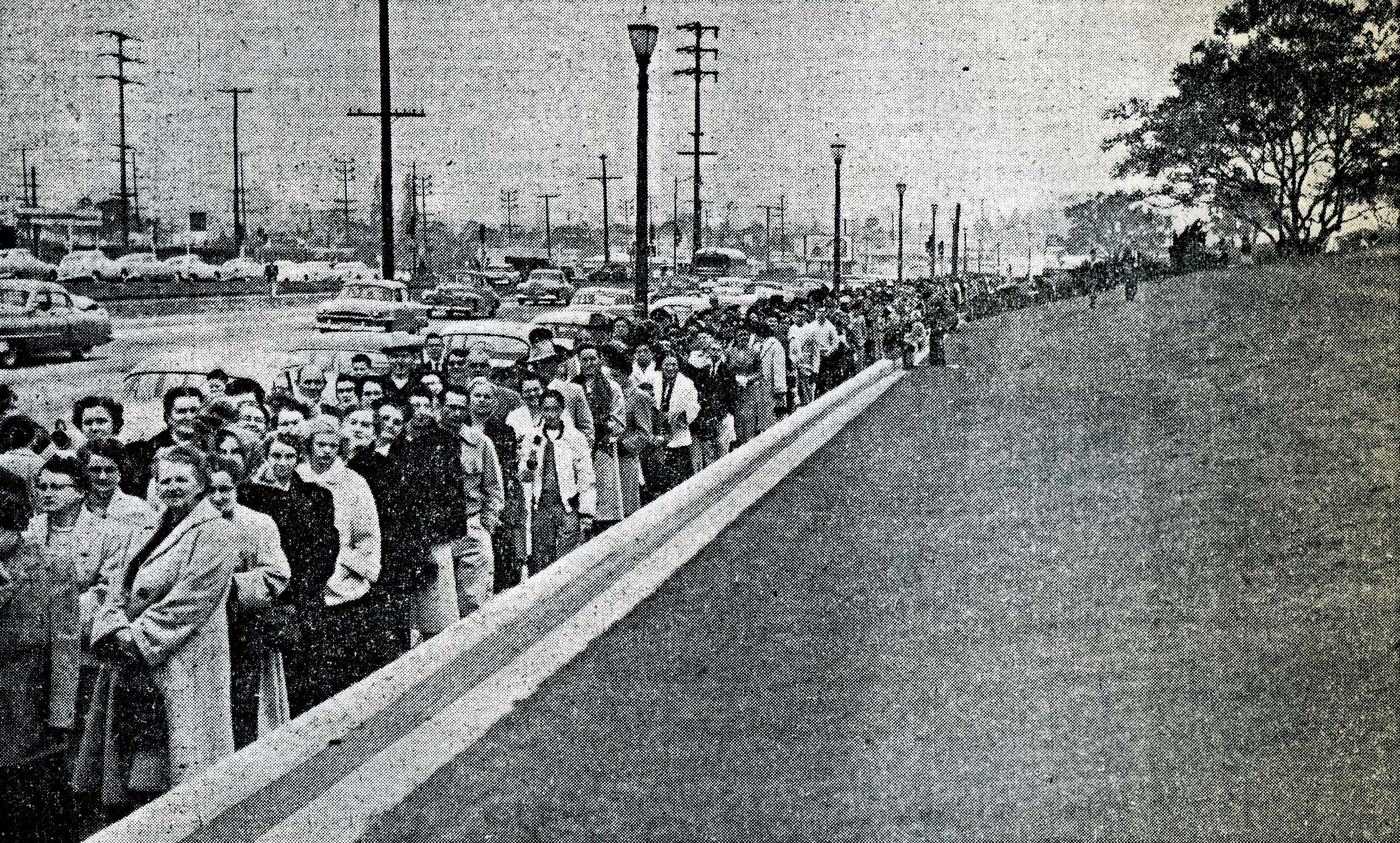 The line for the open house. (California Intermountain News)
The line for the open house. (California Intermountain News)
Directing guests in the bureau of information was the responsibility of A. Merlin Steed, president of the temple mission. Parking was under the direction of President E. Garrett Barlow of the Santa Monica Stake, assisted by a corps of uniformed attendants. Directing the tours inside the temple was the stewardship of President L. Lloyd Prestwich of the Redondo Stake, with volunteers coming from all over Southern California. President Austin Gudmundson of the Inglewood Stake was responsible for recruiting the volunteers. President John M. Russon of the Los Angeles Stake headed the personnel committee. Printing and distributing invitations was the responsibility of President Hugh C. Smith of the San Fernando Stake, who headed the publicity committee.[28]
The backs of tour invitations included several suggestions: “If you have already seen the temple, please give your invitation to an interested friend.” “Sorry, no children under eight.” Those from eight to fourteen were to be accompanied by an adult. Visitors were urged to carpool or use public transit because “traffic and parking near the temple will be a major problem.” Ladies should wear comfortable shoes because “there will be considerable walking.” Guests were to arrive at the date and time indicated on their invitation.[29] Visitors were urged to leave the grounds as quickly as possible following the tour in order to make room for others.
During the opening weeks of 1956, interest in visiting the temple remained high. A steady stream of visitors walked reverently through the temple, with up to 10,000 coming weekdays and 15,000 on Saturdays. Bureau officials believed that 1,600 visitors per hour was the maximum that could be accommodated. Following one of his frequent visits to Southern California, President David O. McKay gratefully reported that visitors passed through the temple in an orderly fashion. “Despite the speed with which the crowds go through, there is a spirit of reverence evident, and generally speaking all seem duly impressed.”[30]
Even though some of the heaviest rains ever known in Southern California were flooding streets and marooning many areas, 61,193 visitors still came to tour the temple during the last week in January. “Everywhere you go, everyone is talking about the Mormon Temple.” People are seeking open house invitations for themselves or for their friends if they have already visited the building. “Interest in the temple is mushrooming. In offices and factories the subject is the same. You hear people ask, ‘Have you seen the Mormon Temple?’ Here in the glamour capital of the world, the temple is getting ‘top billing.’” President Noble Waite exclaimed, “It is fantastic [to see] the enthusiasm the temple has generated!”[31]
When six busloads of Saints came from San Diego to visit the temple, two women made a special presentation. For over a year Laura H. Harlan and Lily Flegal of the Chulavista Ward had been gathering rags that they wove into rugs on a home loom. During their visit, they donated the products of their handiwork for use in the temple.[32]
A variety of special groups attended the open house. In December, 1,500 educators from the Los Angeles School District visited the temple as guests of Noble Waite, president of the South Los Angeles Stake and principal of the Banning High School, and of Howard McDonald, formerly president of Brigham Young University and at the time of the tours president of Los Angeles State College.[33] Mr. and Mrs. Joseph Abplanalp, who were celebrating their sixty-sixth wedding anniversary, came with ten of their twelve living children. W. Tenney Cannon, a high councilor in the Santa Monica Stake and his son Russell, of Glendale, hosted a group of prominent judges and the former mayor of Glendale.[34] VIPs who came during the regular public open house included Jesse Tapp, chairman of the board of the Bank of America, and R. E. Halowell, general manager of the Southern Pacific Railroad.
Guests with disabilities were accommodated. In January, thirty-nine hearing-impaired Latter-day Saints who had come from Utah in a chartered bus joined one hundred members of the Los Angeles deaf branch for a tour of the temple.[35] Because the tour was .61 miles long and because of the height of the temple rooms, ascending from the basement to the third floor was roughly equivalent to climbing eight stories in an ordinary apartment building, visitors with mobility problems were able to make the tour using wheelchairs. For example, on one weekend in February, Willard P. Burnham of the Wilshire Ward coordinated tours for over 120 persons in wheelchairs.[36]
Cecil B. DeMille, famed motion picture producer, visited the temple as a personal guest of President David O. McKay. Two years earlier, DeMille had hired the noted Latter-day Saint artist Arnold Friberg to design sets and costumes and to produce promotional oil paintings for his well-known film The Ten Commandments. The temple, then under construction, was “only a short distance from DeMille’s studio, and he was curious about the building.” Friberg arranged a meeting between President McKay and the motion picture producer in August 1954. “They instantly took to each other,” Friberg observed. He recalled their conversation:
“Now this temple you’re building up there,” DeMille commented, “I’d like to go through that.”
“Oh, I’ll take you through myself,” President McKay responded.
“Now that’s before its dedicated, I may go through?”
“Yes.”
“Now after it’s dedicated, I may not go through?”
“Oh, we’ll take care of that,” President McKay replied with a smile. “The first thing we’ll do is baptize you!” Both laughed.
On January 16, 1956, the prophet gave Mr. DeMille and his associates the promised personal visit to the temple. Unlike the regular tours, “McKay allowed DeMille to set his own pace. ‘He just wandered around and looked, and absorbed the spirit of the place,’” recalled Friberg, who also was present. President McKay explained to his guest, “The purpose of the temple is to take man from physical man to spiritual man.”[37] Summing up this experience, President McKay affirmed: “Mr. DeMille, a long-time friend and interested student and admirer of the Church and its people, seemed deeply impressed by his visit to the new temple, as were the members of his party.”[38] DeMille commented: “The inauguration of the Los Angeles Temple . . . is an event of importance to the entire community. Architecturally an outstandingly beautiful addition to Los Angeles and this area, the new Temple is still more important as a center of spiritual influence” and is “an inspiration to us all.”[39]
Many other visitors shared their reactions to the tours. A couple from Los Angeles wrote: “Thank you for the generosity you have shown in inviting the public into your temple. A structure which can keep hundreds of people silent for 45 minutes is an achievement indeed. Although the murals are truly magnificent, to me they were secondary to the total effect of serenity accomplished by the clean, sweeping lines and color harmony. It is a tribute to the love of physical beauty and order in us all. It is a monument to our need for peace.” A bank official commented, “After viewing the temple and the wonderful job you and your people have done, I think I now understand better why you are all very proud of the temple and the things for which it stands.” A bank vice president reflected: “The highly complementary comments which we have heard from so many were fully supported by our own experience. Words are inadequate to describe the beauty and feeling of majesty which one has in traversing the halls and rooms of the beautiful structure.” A leader in The Conference of Jewish Women’s Organizations expressed appreciation for their opportunity to visit the temple and for “the warmth, friendliness, and many courtesies” extended to them by Church members. “It was a tribute to the interest which this magnificent place of worship has created in the community that we had such an unprecedented turnout, and that all peoples, regardless of faith or creed, take a personal pride in its splendor.” An official of Tanner Gray Lines tours also was grateful to have their sightseeing buses visit the temple daily. “We have had only the nicest comments from [the tourists] and they consider it a great privilege.” Myron Greenwald, a Latter-day Saint who was an executive of a mortgage loan bank, took a large group from his firm to the temple. “The following day,” he recalled, “the temple was a major topic of conversation at our company.”[40]
The spirit of the volunteer guides was a frequent topic of comment. One couple believed that their tour of the temple “was a wonderful event for us and we feel as though it is a right step into the future for us. In all this land nothing I have seen has been so beautifully done in perfection of harmony.” Another visitor affirmed, “Regardless of the crowd, the tour through the temple was conducted so wonderfully and lovingly we will always remember this experience with great joy even though we are of another faith.” Yet another guest described the temple as “a masterpiece of beauty, harmony and devotion. Thank you so much for the privilege of this inspiration and opportunity to know and understand the teachings and what the Mormons think of Christ.” Another Christian group wrote:
The Harvester Bible Class of Hollywood First Presbyterian Church thanks you sincerely for the opportunity to see your beautiful temple of worship. This was made possible by your sharing with others the fine, new edifice soon to be dedicated. . . . . It was a day we will never forget. The beauty and magnitude were completely overwhelming. One thing we all noted was how friendly and helpful everyone was—always a smile, but then I guess they have so much to be proud and grateful for. Thank you again for a very memorable day.
Lloyd L. Austin, president of the Security-First National Bank of Los Angeles, affirmed that the temple “exceeds in beauty anything that I have ever seen in the nature of a contemporary house of worship. You and the principals of your corporation are to be congratulated for the completion of such a marvelous work, both for the church and for this community. I believe you are aware of the high regard with which all of us hold your group.”[41]
After visiting the temple, Donald F. Caswell, education editor of the Los Angeles Examiner, wrote:
For myself and three other members of my family who enjoyed the flawless hospitality of your church on January 25, I want to tell you what a priceless treasure was added to our lifetime of memories by our visit to the temple. I can testify that your church made at least four good friends on that day. In 22 years of professional journalism, I have been subjected to the blandishments of the world’s greatest public relations experts, statesmen, educators and military officers. But the pre-dedication showings of your new temple are without equal as the most brilliant public relations job I have ever seen. Surely, multiplying the number of your visitors by 10 would give a conservative estimate of the number of ‘outsiders’ whose opinion of your faith has been improved.[42]
Harold J. Powers, lieutenant governor of California, was one of the thousands visiting the temple early in February. His letter of gratitude stated: “As Lieutenant Governor, I would like to thank you on behalf of the State for making it possible for so many thousands of Californians to see the beauty and magnificence of the edifice the Latter-day Saints have created in our midst. It is certainly a tribute to your Church and its faithful followers and is symbolic, I think, of the always great role your people have played in our moral, spiritual, and economic development.” He was impressed “by the courtesy and charm of those who were in charge. The visits by so many people required a great deal of tact, planning and organization, and you and all the others who were responsible are to be congratulated.”[43]
Mr. Dastur F. A. Bode, a Farsi-speaking Zoroastrian high priest from Bombay, India, dictated his feelings to a worker in the bureau of information. “Our visit to this temple has been of very great value. It has conveyed to us what devotion, love, and understanding can achieve. The whole temple represents the true spirit of life and living. All its beautiful paintings and halls elevate the devotee and bring the true spirit of religion to the heart. . . . Our experience here tells us what love can accomplish. What we need today in the world is that deep understanding of humanity and the cultivation of true spiritual friendship whereby a new world of joy and happiness can be made possible.” [44]
Although the recorded introduction at the beginning of the tours stated that no gratuities would be expected, many visitors still expressed a willingness to make a contribution. “This is just a note of thanks to all of the kind men and women who gave so generously of their time that we might see this structure of beauty,” wrote one grateful visitor. “It was a pleasure, the memory of which I shall treasure the remainder of my life. While we were informed that no gratuity would be asked or accepted, it does seem that the small sum of 10 or 15 cents from each person would help in covering the cost of replacing the carpets worn thin by so many thousands of pairs of feet. Each one of us would happily have donated many times this amount for such a rare experience.”[45] Fortunately, this would not be necessary.
Volunteer guides also had special experiences. One of them, Ora Pate Stewart, wrote:
For those of us who were privileged to act as guides at the Temple on Thursday, January 12, it could be said that we witnessed on a scale rather larger than miniature, the literal gathering of Israel, when hundreds of people of Jewish ancestry gathered to go through the Los Angeles Temple. To see the expressions upon their faces, to hear their outbursts of appreciation and respect, was to feel a tugging at soul-roots; and we felt cultivated in our common ground.
“Thank you, thank you!” they would whisper, “for the beauty and the peace.” And with my answering smile I wanted them to hear, “And thank you—for Abraham and Moses, and the prophets, and David, and your own beautiful Temple which you will restore someday soon. And thank you mostly for the Bible. We are two branches in the hand of God. We are thankful together!”
I stood at a most beautiful spot, where the lion and the lamb represented the peace of the Garden of Eden. Again and again I was to hear, “And the lion and the lamb shall lie down together.” And sometimes one would add, “The time will come.” There seemed to be a yearning in their faces for that time to come, and I felt a surging conviction that communions of this kind will bring that time nearer, will hasten the day.
The beauty, the color, the pureness of the art in that Garden Room are beyond the power of words to describe. Surely the artist, Mr. Edward T. Grigware, was brushed with divine inspiration. He has made it a garden where God could walk, and where Adam and Eve might be seen, strolling in the cool of the evening. The little white lamb is so without blemish that he might be the one selected for the first sacrifice, after Adam and Eve had left the garden. But the garden would not be the same without him.
As the people arrived at this spot they reached for words to express the emotions that they could not contain. “Beautiful,” and “marvelous,” were whispered from thousands of lips. When words could not be found there were sobs that came from deep inside, and sometimes prayers, a sentence at a time. When mature men and youths came by with tears standing in their eyes or streaking down their cheeks, I felt the dry places in my soul being watered.
“I don’t feel clean enough,” one woman said. And “This is paradise,” expressed the feelings of hundreds.
Perhaps the climax of my day was when a woman stopped directly in front of me and whispered in a voice weighted with prayer, “Almighty God! This is heaven!” and collapsed into my arms with a total loss of strength.[46]
Another Church member, Ruth I. Devereaux, expressed her feelings in poetic form:
In the Garden Room
Hushed was this garden created by man
Of pigment, of color and skill,
Depicting the scenes when the world first began
To exist, through God’s heavenly will.
I stood there, as dawn cast its earliest light
Through tall, sculptured windows, and saw
The glories of talent, in artistic delight,
Adroit hands were inspired to draw.
There, in one corner, a waterfall tossed
Its surplus in crystalline spray
To a half hidden stream, green velvet embossed,
Catching wisteria tears on its way.
Graceful necked swans skimmed the mirror-like pool,
On the bank, a lioness played
With her cub, while a lamb, dressed in ermine white wool,
Expectantly watched, unafraid.
Like echos of last evening’s radiant sunset,
Flamingo wings, tinting their way,
Descended near huge arms of driftwood, moss-wet
With dew-pearled gems on display.
Time claims no space where tranquility reigns,
No mark of confusion, nor trace
Of earthly desires. Here nature attains
Its splendor in beauty and grace.
I walked, in this garden created by man,
In rapture, as they might have known
Who came, as fulfillment of heavenly plan,
To inhabit their first Garden Home.[47]
Many local businesses congratulated the Church on the completion of the temple. Richfield Oil, for example, affirmed: “A new light shines on the people of Los Angeles, with the dedication of the new Temple of The Church of Jesus Christ of Latter-day Saints. Even more beautiful than its architectural splendor is the faith and devotion of the men and women who made it possible.”[48]
The pace quickened as the open house period drew to a close. About 15,000 visited on weekdays, and each Saturday broke the record of the week before, reaching 24,620 on February 11. On this day, the 500,000th visitor, James Bolster, age 97, was formally greeted by the temple mission presidency in the bureau of information. During the last week, visitors arrived as early as 6:30 a.m., an hour and a half before tours began. Soon people were standing four abreast in lines a half mile long on Selby Ave. and Santa Monica Boulevard. At the peak of the rush, they waited for up to two hours for the forty-five minute tour.[49]
Tours ended Saturday evening, February 18, 1956. A total of 662,361 persons had visited the temple during the fifty-one-day public open house. Approximately 23,000 others had visited earlier. This indicates that nearly 700,000 persons had the opportunity to see the beautiful temple in person before its dedication.[50] Later, some 600 Orange County Stake volunteers, working in four-hour shifts during a ninety-six-hour marathon, sorted approximately 650,000 invitation tickets according to point of origin. They determined that 90 percent of the open house visitors had come from California. This total of about 550,000 was impressive when the total number of Latter-day Saints in the Golden State was only about 100,000. Utah provided the second largest group. Many other states and fifty-six foreign countries were also represented.[51]
Local newspapers used superlatives in describing the temple. The Los Angeles Times published a well-illustrated feature about the temple beginning on the front page; Dan L. Thrapp, the paper’s religion editor, referred to the “impressive art” as he described the ordinance room murals.[52] The Ventura Star Free Press and Anaheim Bulletin described the temple as “a new beacon” on the Los Angeles skyline and its tower as “a silent sentinel to all it surveys below.”[53] The Mirror-News related how local members had willingly sacrificed to raise over a million dollars for the temple and then quoted A. Merlin Steed, the visitor’s center director, who insisted that the beautiful temple “is not a monument to those who built it, although it will be an everlasting credit to them, it is a monument to our Father in Heaven. This house is dedicated to Him.”[54] The Los Angeles Times also quoted Steed, who anticipated that the new temple would “bind” Latter-day Saint families into a “tight-knit” Southland community.[55]
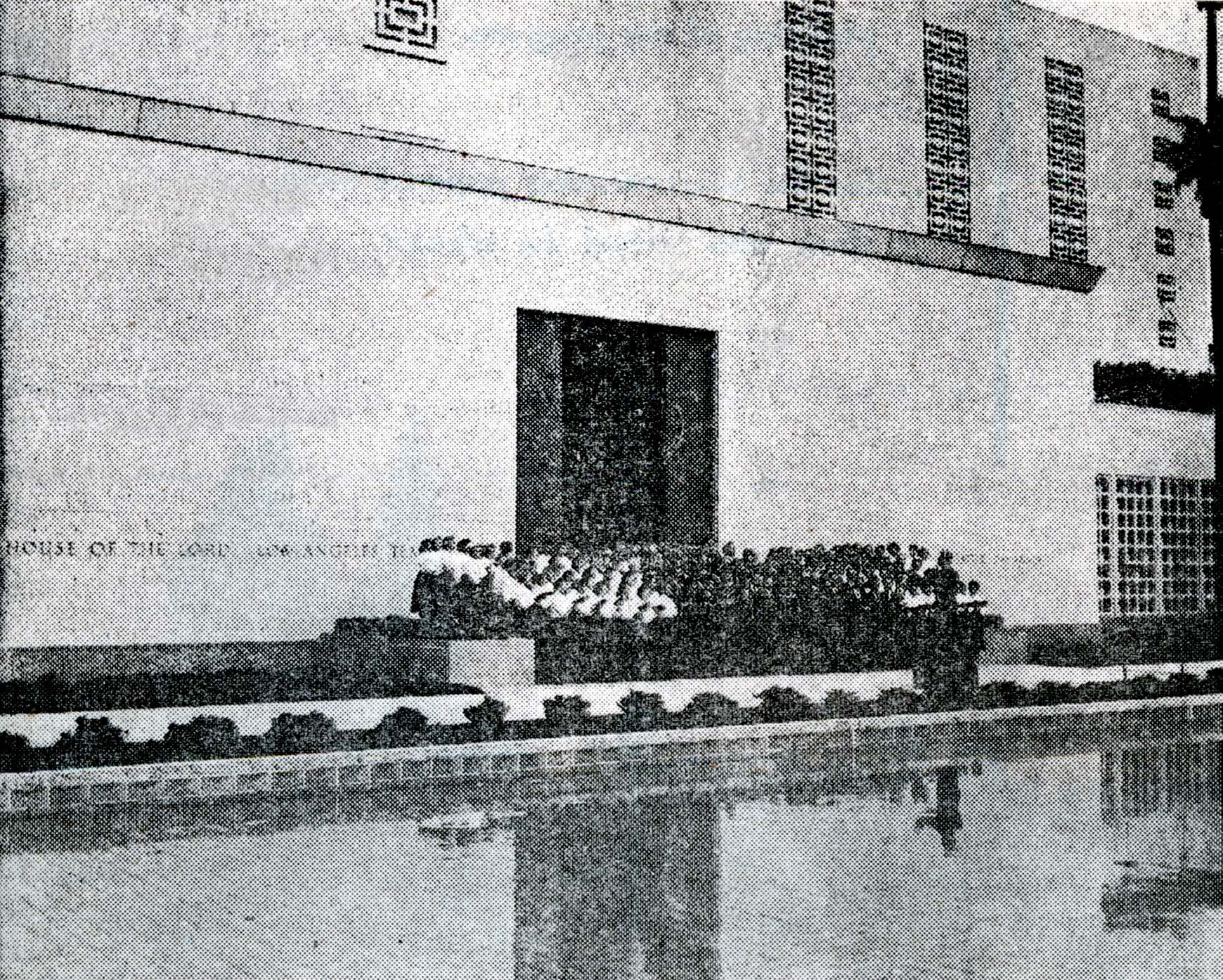 Mormon Choir of Southern California during special broadcast. (California Intermountain News)
Mormon Choir of Southern California during special broadcast. (California Intermountain News)
On March 4, a local television station carried an hour-long program featuring the new landmark. This broadcast was seen at 11:00 a.m. on KTTV, Channel 11 in Los Angeles as part of its weekly series “Great Churches of the Golden West.” It was narrated by Reverend Clifton E. Moore, director of radio and television for the Los Angeles Presbytery. The program opened with the 180-voice Mormon Choir of Southern California singing “High On the Mountain Top” from the temple’s front steps by the reflecting pool. The scene then shifted to a special meeting in the Westwood Ward chapel where President John M. Russon greeted the television audience on behalf of the Church and Norma Done spoke representing the youth. After a male chorus sang “An Angel from On High,” President Howard W. Hunter of the Pasadena Stake gave the main address, testifying of the Restoration and explaining the mission of the angel Moroni. The focus then returned to the temple. Viewers gained an impression of the building’s size as the television camera slowly moved the 250-foot length of the upper assembly room, all the time focusing on the Southern California Mormon Choir at the far end as they sang. The program concluded with a tour of the temple and views of its exterior. The program’s sponsor, Inglewood Park Cemetery, reported that immediately afterward they received numerous phone calls thanking them for bringing this program to the vast television audience and asking when it might be rebroadcast.[56]
Following the close of public tours, the temple was thoroughly cleaned, and some last-minute details were completed in preparation for the long-anticipated dedicatory services three weeks later. Leaders expected that some of the carpeting would need to be replaced after it had been pounded by over a million feet during the open house. Rainy weather undoubtedly also resulted in many muddy shoes during the tours. Actually, “carpeting throughout the building has withstood the ‘trek’ remarkably well with but few areas showing signs of wear.” Light-colored carpeting in ordinance room aisles needed to be shampooed, and only a small section in the grand stairs hall on the main floor needed to be changed. This was accomplished at a total cost of only $178.50. Because the tours started in the bureau of information and visitors walked through the 500-foot-long utilities tunnel, they reached the temple with relatively clean shoes. Architect Edward O. Anderson was sure that this “helped materially in preserving the carpeting.”[57]
Preparations for dedication were also made outside. Oxalis weeds had infested the lawn. The only way to eradicate them was by pulling them out by hand. Seminary students from the Brentwood, Westwood, and Wilshire Wards were recruited to accomplish this task. One of them later reflected: “What an extraordinary sight it must have been to passers-by on Santa Monica Blvd. to see hundreds of youth kneeling on the lawn in squares marked off by string. They probably thought it was some peculiar ritual associated with the strangeness of Mormonism.”[58]
The Temple Dedicated
The climaxing event, the temple dedication, was planned carefully. President McKay and other Church leaders discussed details with Southern California leaders during several visits. They formed a local public relations committee composed of three stake presidents: Hugh Smith (San Fernando Stake) as chairman, with Howard W. Hunter (Pasadena Stake) and John M. Russon (Los Angeles Stake) as members. Ned Redding, publisher of the California Intermountain News, became executive director of press relations with headquarters in the bureau of information. Elder Harold B. Lee of the Quorum of the Twelve Apostles was in charge of arrangements for dedicatory events.
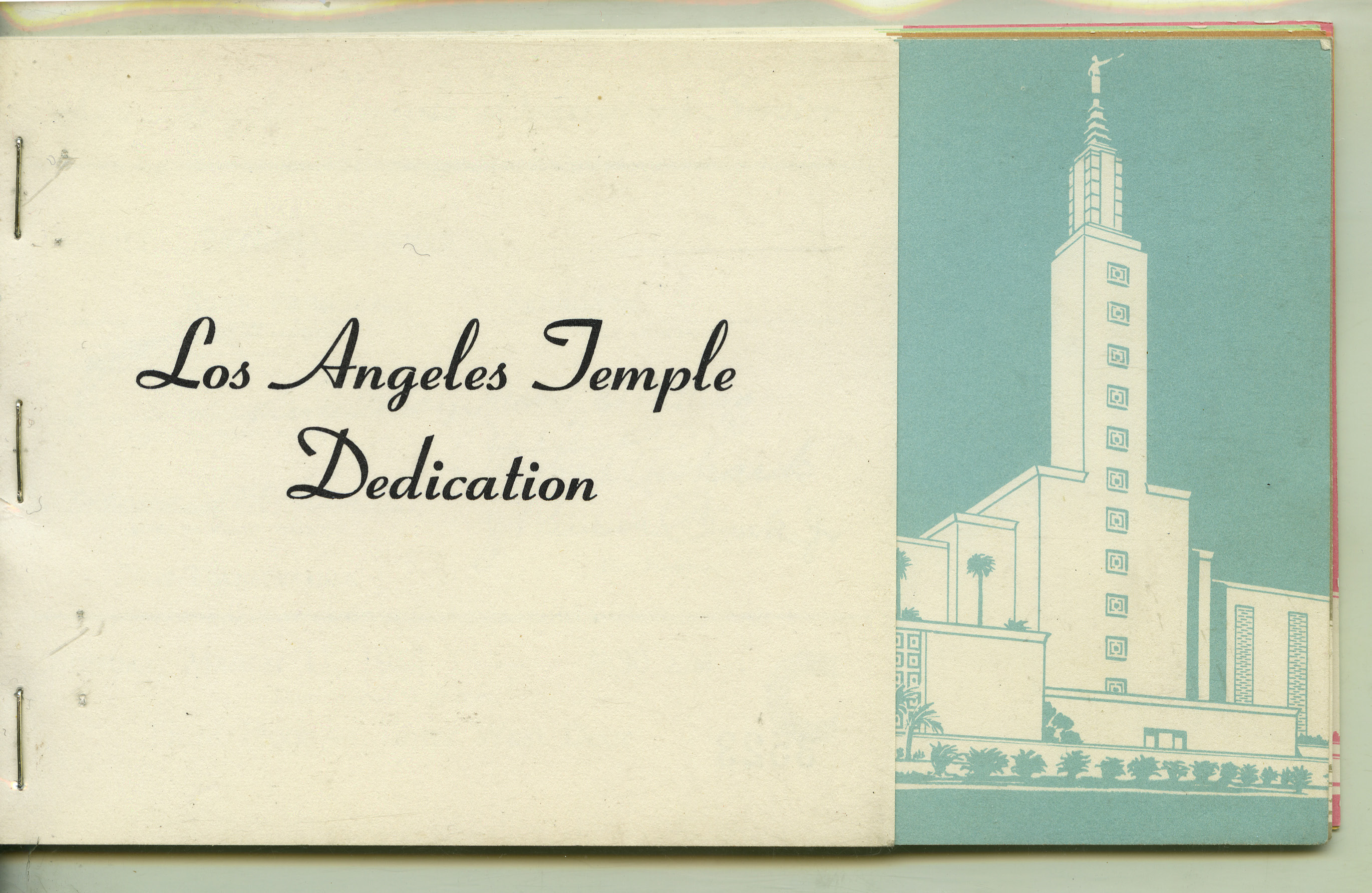 Los Angeles Temple Dedication brochure. (Scrapbook)
Los Angeles Temple Dedication brochure. (Scrapbook)
Stake, ward, and mission leaders and their spouses were assigned to attend the two dedicatory sessions on Sunday. Members of designated stakes were then assigned to specific sessions on Monday, Tuesday, or Wednesday. Church members in Southern California who wished to attend needed to be interviewed by their local ecclesiastical leaders who would assure that those attending were temple worthy. Saints outside of the temple district were likewise to obtain a temple recommend from their local leaders which they were to mail to the dedication seating committee at Church headquarters in Salt Lake City. Gordon B. Hinckley, an employee of the Church Missionary Committee (not yet a General Authority) who served as secretary to this committee, would then mail out tickets to a particular session.[59] The Tooele Stake just west of Salt Lake City chartered a special Union Pacific train to carry the faithful to Los Angeles; after leaving Salt Lake City, this train made several stops in the Tooele area to pick up passengers.[60]
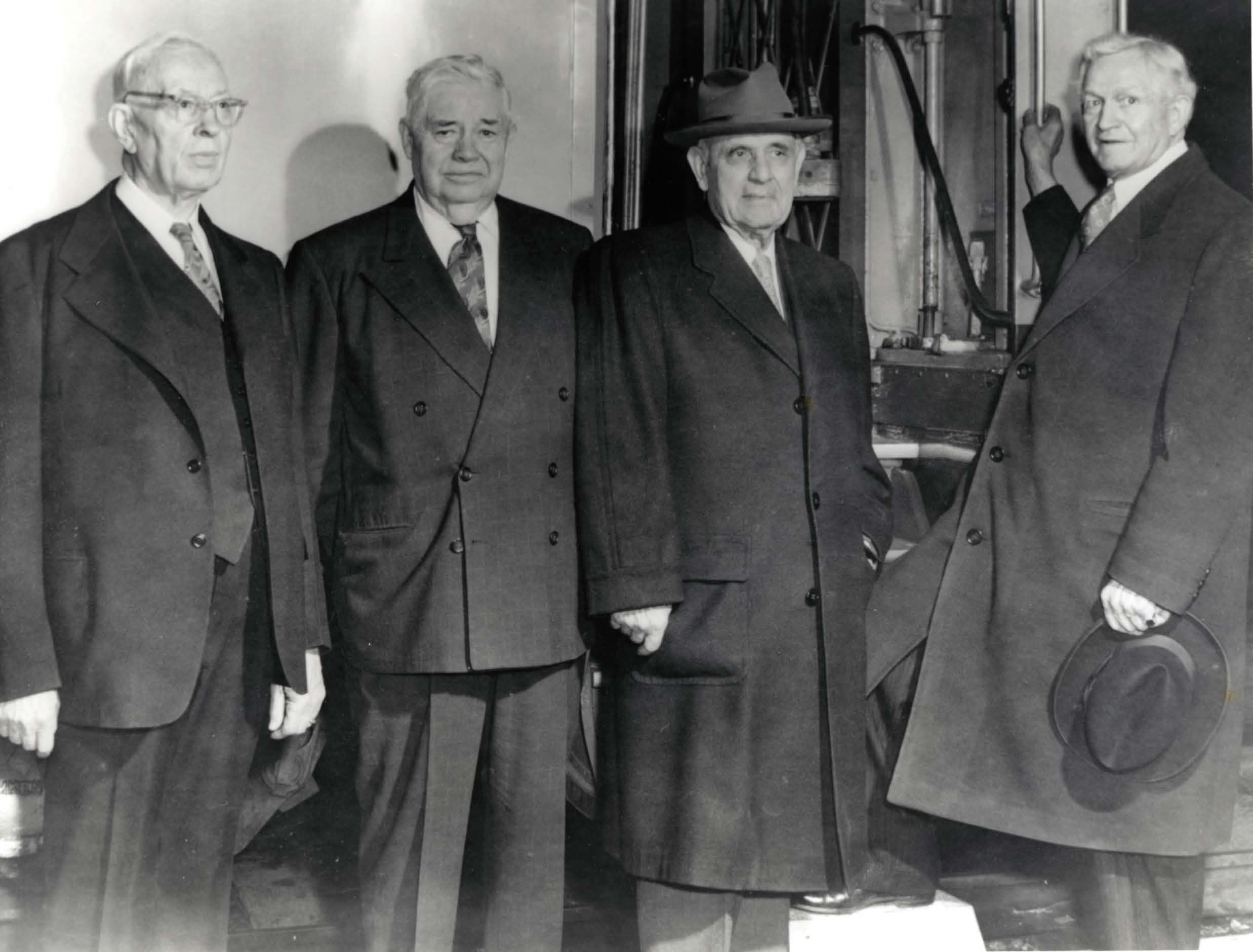 Boarding the train. Left to right: Joseph Fielding Smith, J. Reuben Clark Jr., Stephen L Richards, and David O. McKay. (Scrapbook)
Boarding the train. Left to right: Joseph Fielding Smith, J. Reuben Clark Jr., Stephen L Richards, and David O. McKay. (Scrapbook)
All the General Authorities of the Church were invited to attend. A large group came by train.[61] As President David O. McKay was about to board in Salt Lake City, he declared the dedication of the large Los Angeles Temple to be “one of the significant events in the entire history of the Church.”[62] They were greeted at Union Station Friday morning, March 9, by Benjamin L. Bowring, recently appointed Los Angeles Temple president; A. Merlin Steed, director of the bureau of information, Henry D. Taylor, president of the California Mission, and by members of the temple committee. Members of the First Presidency and Quorum of the Twelve immediately separated into two groups to attend “special functions at which Los Angeles civic leaders recognized the great contribution of the Church to this area.” One group, headed by Presidents David O. McKay and J. Reuben Clark Jr., attended a special luncheon sponsored by the Los Angeles Chamber of Commerce at the California Club. The other group, headed by President Stephen L Richards and several Rotarians, went to the Los Angeles Rotary Club luncheon at the Statler Hotel downtown. Yet another luncheon was held for the visiting ladies at the new Beverly Hilton Hotel; at this function, Relief Society General President Belle S. Spafford was invited to report on her experiences while attending the International Council of Women’s conference in Helsinki, Finland, two years earlier.
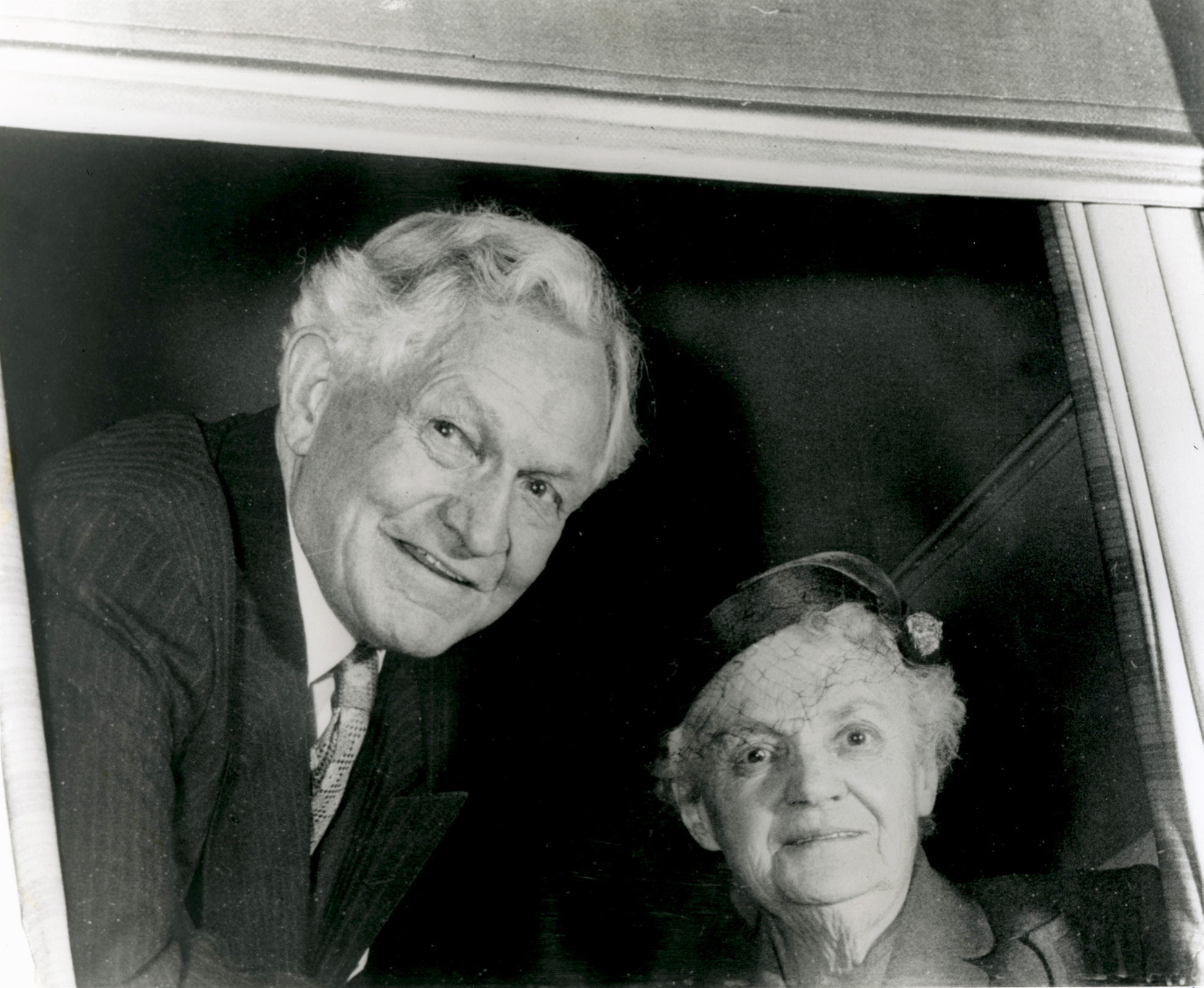 President and Sister McKay aboard the train. (Scrapbook)
President and Sister McKay aboard the train. (Scrapbook)
Church leaders disclosed that the cost of erecting the temple was about $4 million (more than $28 million in the early twenty-first century). Including the other buildings and facilities on the temple site, the cost was closer to $6 million. When plans for the temple were announced, Church leaders asked the California Saints to raise $1 million of the estimated cost of $4 million. Pledges totaled $1,648,000, more than one and a half the amount that had been assigned. As Church leaders were gathering for the temple’s dedication, President W. Noble Waite, chairman of the local temple committee, was pleased to report that this fund-raising goal had been reached. The total actually contributed was even greater, $1,682,994.14. As he expressed appreciation for the Saints’ generosity, he affirmed that this was “an exercise of faith and an evidence of the strength of [their] testimonies.”[63]
Government leaders sent proclamations congratulating the Church on this occasion. California’s governor, Goodwin J. Knight, insisted: “This temple truly reflects the profound devotion and dynamic force of your faith on the side of justice, morality, of faith and human dignity. The entire aspect is indeed one of grace, solidarity, harmony and serenity.” Mayor Norris Poulson congratulated the Church for selecting Los Angeles as the site for the temple and affirmed that it has already become a tourist attraction in the city. “But more important still,” he acknowledged, “are the spiritual values and great labor of love that will proceed from this sacred edifice.” The city council likewise adopted a resolution that “extends welcome to the visiting Church dignitaries and congratulates them and the Latter-day Saints of this area, who have contributed so much to the cultural and ecclesiastical betterment of this community.” In their resolution, the county board of supervisors asserted that “the Mormon Temple is one of the most outstanding buildings of its kind in the entire world” and described the dedication as “a day that will commemorate for all time an important event in the religious history of Los Angeles County.”[64]
The dedications of these sacred houses of the Lord have always been eagerly anticipated spiritual events. To dedicate something means to set it apart as holy or devote it to sacred purposes. “Dedicate” is often linked to “consecrate” from the Latin cum (together) plus sacrare (to make sacred). When a temple is dedicated, it is specifically given to the Lord whose house it is to be.
In Old Testament times, temple dedications were special occasions. When the tabernacle of Moses was completed, “a cloud covered the tent of the congregation, and the glory of the Lord filled the tabernacle.” These manifestations of God’s accepting presence were so powerful that even “Moses was not able to enter” (Exodus 40:34–35).
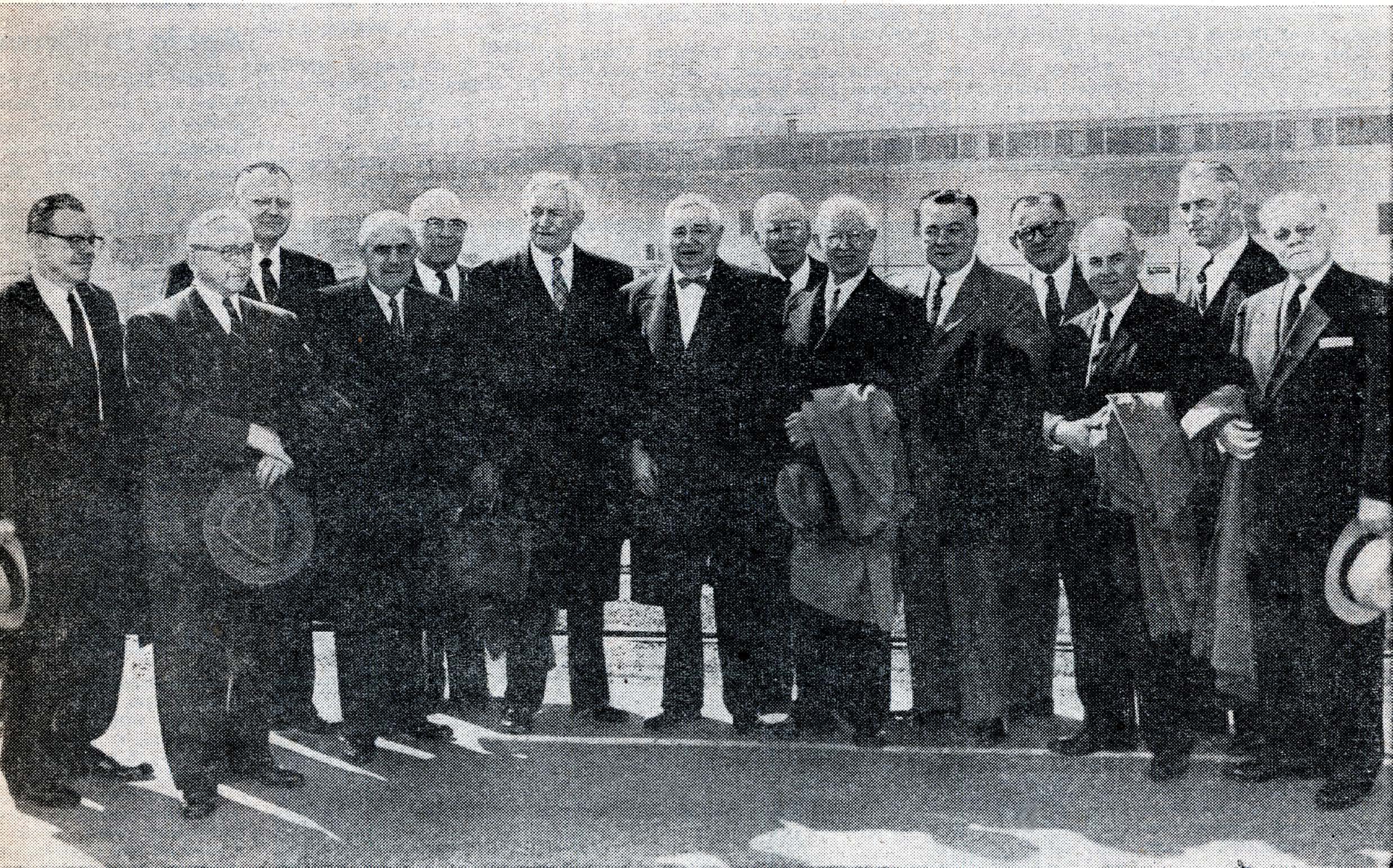 The First Presidency and the Twelve arriving in Los Angeles. (Scrapbook)
The First Presidency and the Twelve arriving in Los Angeles. (Scrapbook)
The dedication of Solomon’s temple in the promised land was a similar spiritual occasion. Countless animals were sacrificed as the ark was taken into the temple and placed in the Holy of Holies. Once again a cloud of the Lord’s glory “filled the house of the Lord” (1 Kings 8:4–11). In his prayer of dedication, King Solomon petitioned, “The Lord our God be with us, as he was with our fathers: let him not leave us, nor forsake us: That he may incline our hearts unto him, to walk in all his ways, and to keep his commandments, and his statutes, and his judgments, which he commanded our fathers” (1 Kings 8:57–58). At the conclusion of the days of dedication the people left—as would the faithful in later dispensations—“joyful and glad of heart for all the goodness that the Lord had done” for them (1 Kings 8:66). In the latter days, the 1836 dedication of the Kirtland Temple climaxed a season of remarkable spiritual outpourings.
Temple dedications have been scheduled in different ways over the years. The pattern of having more than one dedicatory session was established at the outset in Kirtland, when a second session was scheduled four days afterward for those who could not get into the initial dedicatory meeting. The Nauvoo Temple was dedicated piecemeal—separate dedications being conducted for the baptismal font and the ordinance facilities on the attic level as they were completed. This pattern was repeated at St. George. At the Nauvoo and Manti Temples, a private dedication was conducted before the public dedication because of fears that there might be disruptions during times of persecution. The Salt Lake Temple’s thirty-one dedicatory sessions extended over nineteen days. Portions of the Mesa Arizona and Bern Switzerland Temple dedications were broadcast by radio.
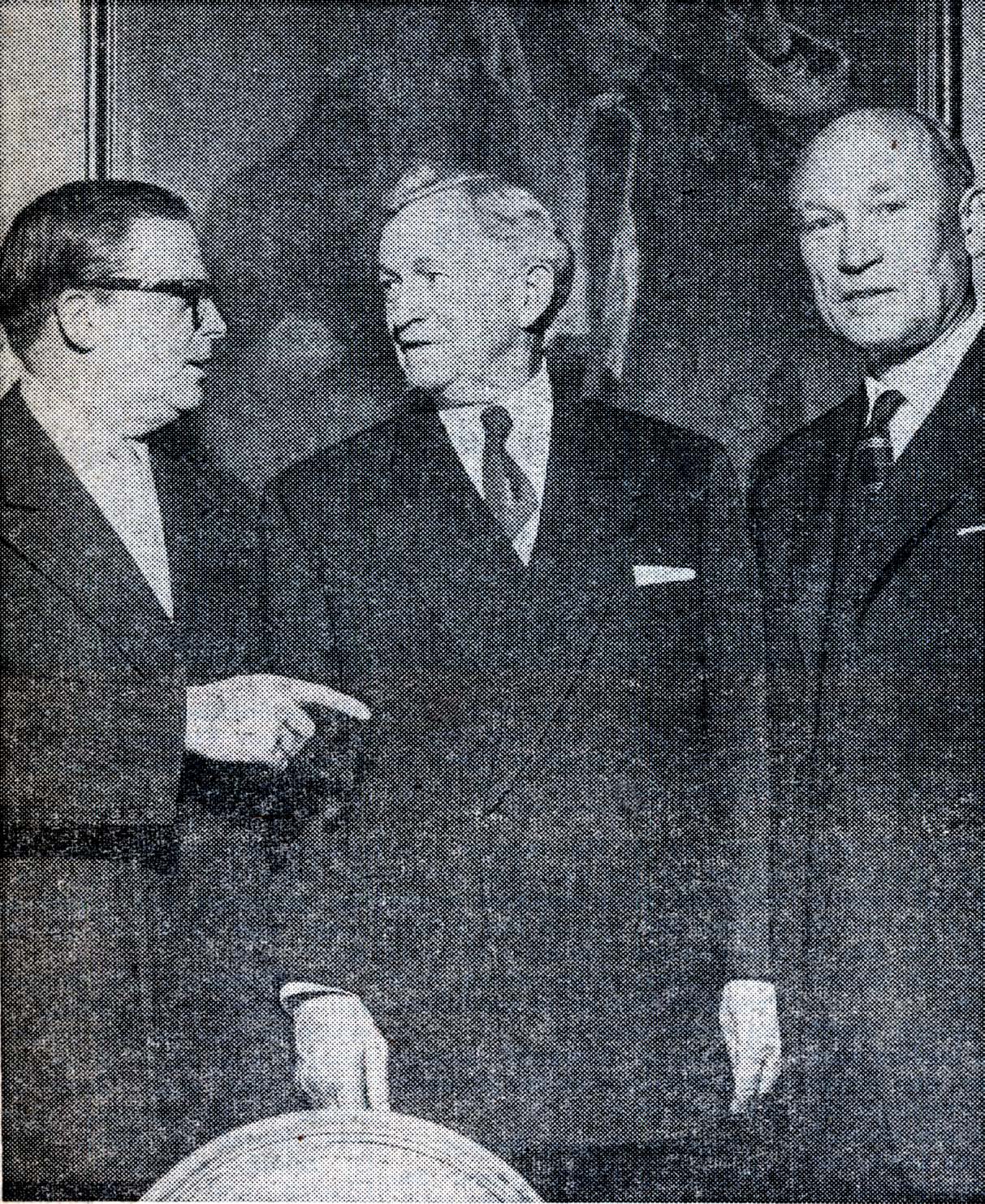 Los Angeles mayor Norris Poulson, President David O. McKay, and chamber of commerce president Thornton Beckman. (Church News)
Los Angeles mayor Norris Poulson, President David O. McKay, and chamber of commerce president Thornton Beckman. (Church News)
During the four-day dedication of the Los Angeles Temple, a corps of three thousand men and women were needed to handle such tasks as parking, checking tickets, and ushering. All the area stakes participated in providing these volunteers. Because only those attending the dedication were permitted to enter the grounds on these days, the bureau of information remained closed.
The Dedication Proceedings
The dedicatory services in Los Angeles would take place in the large assembly room on the third floor where twenty-six hundred could be seated. For the first time, closed-circuit television would carry proceedings to other areas in the temple where at least thirty-four hundred more could view them. These included the ordinance rooms, chapel, cafeteria area, and even some wide hallways. The First Presidency sent Gordon B. Hinckley to supervise these arrangements; he set up his office in the basement of the bureau of information. Fifty 24-inch televisions, loaned free of charge by Hoffman, were set up throughout the overflow areas in the temple. They carried the proceedings via a special closed channel set up by KSL-TV, which had brought a transmitter truck from Salt Lake City for this purpose.[65] Eight years later, at Oakland, closed-circuit television would carry the dedicatory proceedings into a different building—the adjoining Interstake Center. Then in later years, dedication proceedings would be transmitted even more widely. Likening these marvels of modern communication to divine revelation, President McKay commented, “How easy it must be in the spirit world to tune in on an occasion of this kind.” In Los Angeles, there were eight dedicatory sessions, beginning at 9:30 a.m. and 2:30 p.m. each day from Sunday, March 11, through Wednesday, March 14, 1956. This meant that nearly fifty thousand persons could participate in the dedication.
President McKay and his counselors sat at the highest level of pulpits at the east or Melchizedek Priesthood end of the hall. With all the General Authorities present and participating, the temple dedicatory sessions were not unlike the general conferences of the Church. Seated adjacent to the Aaronic Priesthood pulpits at the west end of the hall, the Mormon Choir of Southern California led by H. Frederick Davis provided music for both Sunday sessions; organists were Karleton Driggs in the morning, and Cicely Adams Brown in the afternoon. On the other days, combined stake choirs provided the music. President David O. McKay spoke and personally offered the dedicatory prayer in each session.
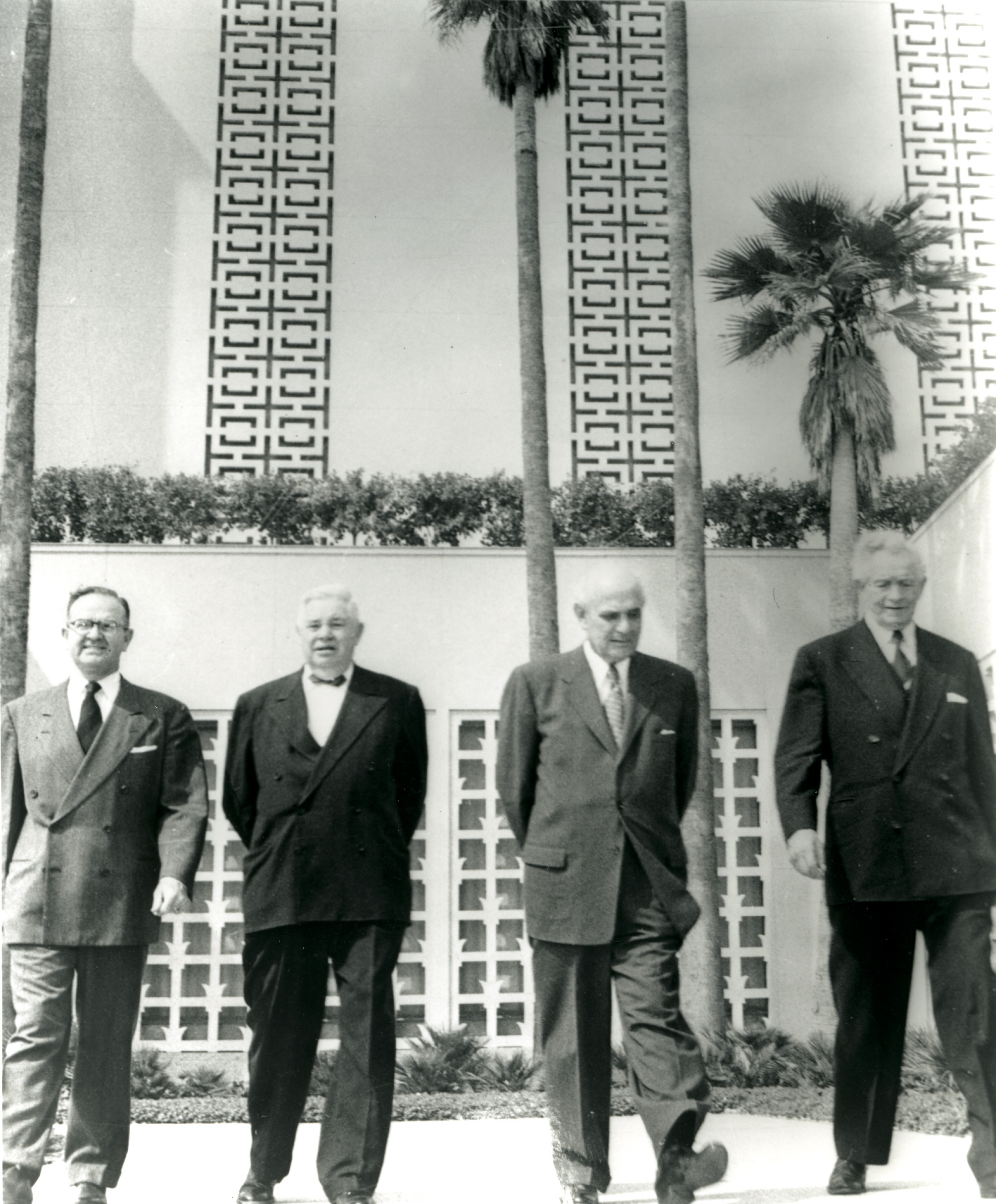 Temple president Benjamin L. Bowring with the First Presidency. (Scrapbook)
Temple president Benjamin L. Bowring with the First Presidency. (Scrapbook)
Approximately six thousand faithful Saints sat in reverent silence for an hour in various parts of the temple on Sunday morning as they awaited the beginning of the event they had looked forward to with such great anticipation.[66] President David O. McKay opened this session by stating that this was perhaps the most memorable temple dedication in the history of the Church and that he could only use superlatives in reference to the temple. It was the largest temple ever built by the Church, and the largest number of people in history had attended its open house and would participate in its dedication. He then expressed gratitude “for the faith, the loyalty and the devotion of the people of this temple district in their voluntary contribution of a million, six hundred thousand in addition to their efforts to build needed chapels during this same period.” He affirmed that the Church’s one and one-half million members worldwide were rejoicing on this occasion, and then testified that “there are many in the unseen audience who are [also] rejoicing today because of their vision of and their work toward the building of a temple in this area.” Specifically he mentioned three individuals “whose names will ever be associated with the early beginnings of this temple”: President Heber J. Grant, who purchased the site; David P. Howells, who helped to find it; and Preston D. Richards, who handled the legal negotiations. “They are not occupying seats in any of the rooms, but I am sure they are here with us in spirit.” Also among those who are rejoicing, President McKay declared, are Joseph Smith who recorded the Lord’s command to build a house to His name, and Brigham Young who prophesied that the Pacific would be “overlooked from the house of the Lord.”[67]
President McKay’s counselors in the First Presidency also spoke during the Sunday morning session. President Stephen L Richards was convinced that “the Spirit of the Lord has been manifest in the planning and construction of this beautiful temple. . . . His hand has been in the work from the selection of the site to this day of dedication,” President Richards affirmed. “This day we will give all of it to Him, and then He will give it all back to us for the use and blessing of His people.” He then described our vicarious work for the dead as “the most truly Christ-like service performed in the Church. It not only conserves a principle of universal justice, . . . but it embodies characteristics and attributes of service approaching those of the Master himself.”[68] President J. Reuben Clark noted how in former dispensations people took sacrifices to the temple, seeking forgiveness of their sins. Today, in contrast, “We are not here to secure forgiveness for our sins. We are here having forsaken our sins with resultant forgiveness and in a spirit of deep humility, living a life of righteousness, we are here to do the work which is done in these temples and to do which the Lord commanded.”[69]
Stake president W. Noble Waite, chairman of the temple committee, reported that the Saints had actually contributed $33,000 over the amount they pledged but insisted: “It has been no sacrifice. We cannot give enough to the Lord ever to have Him indebted to us.” He then pledged the Saints’ ongoing commitment to operate the temple, to pursue family history research, and to bring their sons and daughters to the temple to be married.[70]
The closing prayer for this session was offered by President John M. Russon of the Los Angeles Stake. President McKay regarded this as one of the most impressive and significant dedications ever held in the Church. There were lumps in many throats and tears in many eyes as the prophet and his party shook hands with as many as possible as they left the hall. He then passed through the utility tunnel to the bureau of information where the General Authorities were served a buffet lunch.
These meals between and following the dedicatory sessions were provided by Elbert Startup and his family, members of Howard W. Hunter’s Pasadena Stake who had just come from Utah to establish a new catering business in Southern California. For over a week ahead of time they prepared and cooked the food to serve. Because there was no kitchen in the bureau, cleanup was a major challenge. Still, President McKay encouragingly put his arm around Elbert’s shoulders and promised, “Brother Startup, if you serve all your meals as carefully and as nicely as you served us, you will be a success.”[71]
During the Sunday afternoon session, Joseph Fielding Smith, President of the Quorum of the Twelve Apostles, spoke about the restoration of the sealing keys by Elijah the prophet “to turn the hearts of the fathers to the children, and the children to their fathers.” Before this time, he insisted, the world knew nothing about ordinances for the dead or the power to seal. He noted that within a few years of these keys being restored, genealogical societies were organized in many areas, and the number of family histories being published exploded. Elder Harold B. Lee, also of the Twelve, likened the direction received in the temple to a pilot climbing above the clouds to be guided by the stars. Elder Ezra Taft Benson, one of the Twelve who was then also serving as US Secretary of Agriculture, affirmed that building this temple had been a blessing not only to the Church but also to the entire nation; in his travels, he has found that this project was being talked about across the whole country.[72]
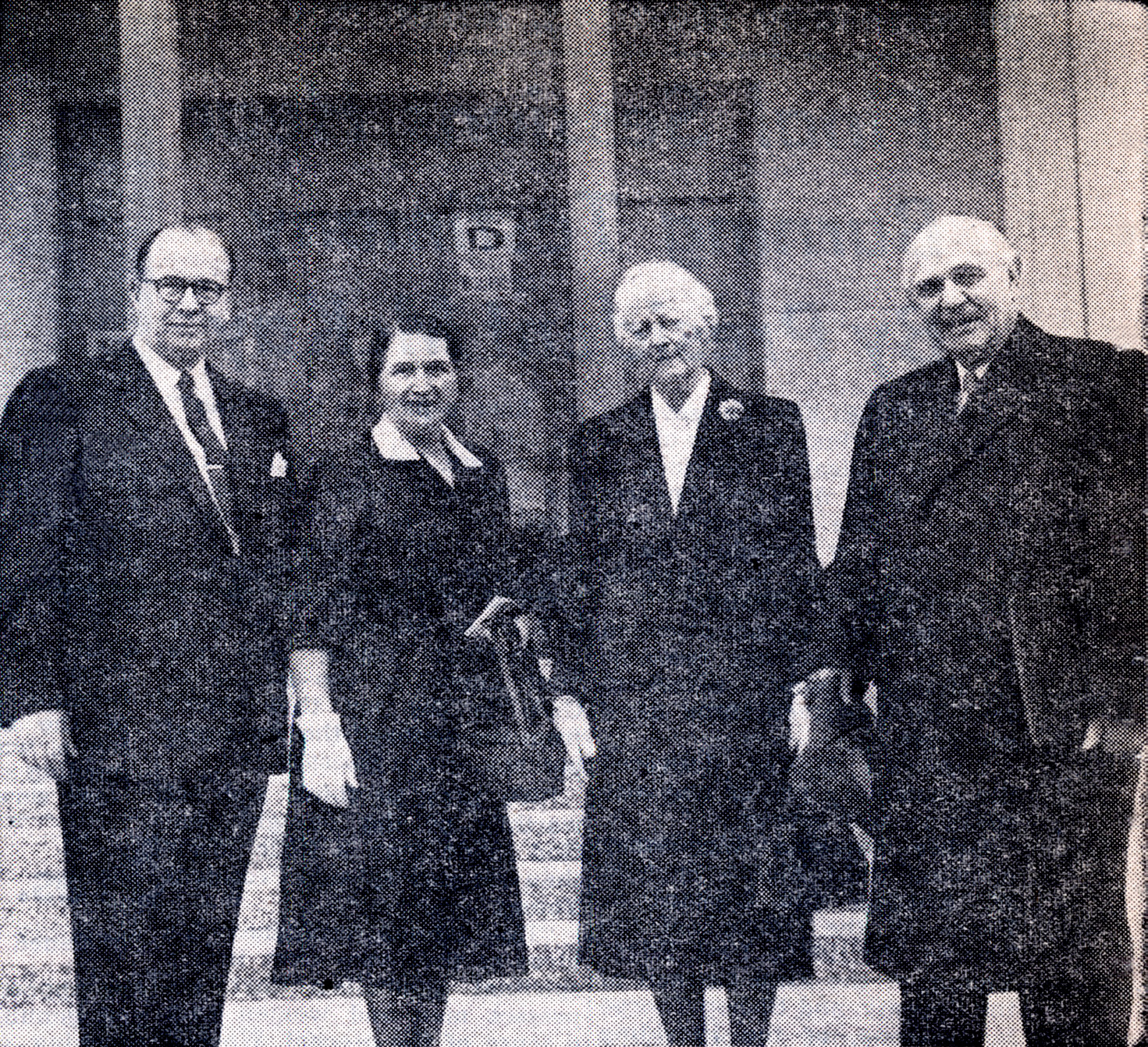 Elder Ezra Taft Benson and President Stephen L Richards and their wives. (Scrapbook)
Elder Ezra Taft Benson and President Stephen L Richards and their wives. (Scrapbook)
In the Monday morning session, Elder Spencer W. Kimball of the Quorum of the Twelve Apostles testified that only in our day has the “fullness” or “completeness” of temple ordinances been revealed. He then described the Saints in the temple district as “200,000 torches to light the way for the people out of darkness into the Gospel of Jesus Christ.” He insisted that “the oil of holiness is necessary to keep those lamps burning” and that being holy is the great challenge of our day.[73]
President McKay spoke in all of the dedicatory sessions, giving a different message in each. On Monday afternoon, he explained that because “we have come with singleness of purpose, with clean hands and pure hearts, we think and feel in unity with our Father in Heaven. It is very easy for me to believe that we are very close to the other side” and that “there are others we cannot see who are joining with us in this temple dedication.” He specifically described similar experiences in Scotland when he was a missionary there and in Hawaii during his 1921 world tour of missions. Elder Mark E. Petersen recalled how he and his wife Emma had walked around the temple on a recent evening. “We felt the sanctity and beauty of this building and felt surely the spirit of the Lord was here.” “Therefore,” he concluded, “it was fitting that the inscription, ‘HOLINESS TO THE LORD,’ be above the entrance to the temple.” Elder George Q. Morris described the temple as “a silent, penetrating testimony to the hearts of the honest” who will want to learn more about it. Elder Clifford E. Young, an Assistant to the Twelve, explained that “we become saviors on Mt. Zion when we are permitted to come to these holy houses and do for those who have gone beyond that which they could not do for themselves. We come here for blessings because our hearts are turned to our fathers, and because we believe our fathers’ hearts are turned to us.” [74]
Members from the stakes assigned to each dedicatory session formed the choir for their particular session. Darlene Hill, a young single adult (and future temple matron), sang in one of these choirs. The Asian flu was raging at the time. She recalled how when the group gathered the night before to rehearse, many could hardly speak because of their sore throats. Under these circumstances, they decided not to practice, but prayed and agreed to come fasting the following day. The choir was seated at the west or Aaronic Priesthood end of the hall. Their opening number, “Preludes to Eternity,” was to commence with very loud notes. Darlene wondered how this would turn out. She was at the left end of her row. As the choir began its number, she turned to her left to see who was singing next to her and right on pitch. She could see nobody there. After the meeting, many in the choir confided that they had the same experience. They knew that the angels had been singing with and supporting them.[75]
Speaking Tuesday morning, Elder Henry D. Moyle of the Twelve insisted that a worthy example of parents would help their children to seek companions with whom they could be sealed in the temple. President Antoine R. Ivins of the First Council of the Seventy lamented that only 45 percent of Saints were marrying in the temple, and he blamed this on a lack of testimony. Elder Adam S. Bennion of the Quorum of the Twelve compared the California Saints’ sacrifice to that of those who built the temple of Solomon. He called this present occasion “a double dedication” because Church members were giving this beautiful edifice to the Lord and should then dedicate themselves to the purpose of this building—to live according to “the real plan of life and salvation.”[76]
In the Tuesday afternoon session, President Joseph Fielding Smith pointed out that baptism enables one to enter the lower portions of the celestial kingdom, but he emphasized that exaltation or eternal life can be reached only through all the ordinances of the temple. Because we do not know just when the Lord will come again, pointed out Elder Delbert L. Stapley of the Twelve, we should always strive to be prepared. He insisted that we should enter the temple worthily rather than going there “to be made worthy.” Elder LeGrand Richards, also of the Quorum of the Twelve, described performing ordinances for those who have gone before as a marvelous work. “If the veil were pushed back and you could know how eagerly they are waiting for their work to be done, wouldn’t the great work seem of more importance to you?”[77]
Speaking Wednesday morning, Elder Spencer W. Kimball emphasized the importance of faithfully honoring the covenants made in the temple. “Everyone fulfilled will take us a step nearer our goal; exaltation in the Kingdom of God. Only in the House of the Lord,” he explained, “can the ordinances be performed to make possible the exaltation of man.” Elder Richard L. Evans of the Quorum of the Twelve noted that there is a similarity between an architect and his creations. The same is true of our Heavenly Father and his earthly creations. The most cherished things of life are the love and companionship we have with loved ones. “Surely a continuance of that sweetness and association is a promise and assurance” that we will enjoy in the heavens hereafter. President Levi Edgar Young of the Seventy declared that “this temple bears witness to spiritual forces without which material achievement is valueless.” “The temple is the closest we shall ever come to God on this earth,” insisted Bishop Thorpe B. Isaacson of the Presiding Bishopric.
In the final dedicatory session Wednesday afternoon, Elder Marion G. Romney, of the Quorum of Twelve Apostles, affirmed that “temples are built that God may reveal unto His people the ordinances and teach [them] the way of salvation.” He described the temple as “the great fortress of righteousness in the world.” As he had done in each of the other sessions, President David O. McKay bore a strong personal testimony of the Savior and the Restoration of his gospel: “He is the Son of God, our elder brother, the head of the Church of Jesus Christ, our guide and light, our eternal savior. I know that God lives. Joseph Smith who saw the Savior and His father is the most blessed man in this dispensation; he brought forth the greatest thing in the world, the Church of Jesus Christ.” A reporter present observed that President McKay had never “seemed stronger or more exalted and inspired in his office.” He gave his talks and offered the dedicatory prayer with “a vigor and depth that belied his years.”[78]
Elder S. Dilworth Young, one of the general authorities present for the dedication, poetically captured his feelings:
Dedication
I sit here and muse about the
Dedication of the temple.
Three thousand people are in this room,
Silent,
Awed.
They came in quietly
Without noise.
They sit motionless,
Silently praying
To be partakers of the
Heavenly influence,
The Holy Spirit.
As the songs are sung,
As the President speaks,
Here and there a handkerchief
Wipes away tears which will not
Be stayed.
Welling up in each heart is knowledge—
Knowledge that “He lives!”
This is the ultimate thing:
Men bear witness of it.
The temple is raised because of it.
To what end?
That we may live also,
And our parents, and
Our parents’ parents;
Our children, and
Our children’s children.[79]
The Dedicatory Prayer
The highlight of each session was the dedicatory prayer. In these prayers, Latter-day Saints give the temple to the Lord to be one of his houses on earth. In contrast to other public prayers which typically are brief, temple dedicatory prayers are longer as they cover many matters. These prayers are written out and then read, perhaps so they can be given word for word the same in each of the dedicatory services.
The dedicatory prayer of the Kirtland Temple, given by revelation (D&C 109), set the pattern for the prayers at subsequent temple dedications. The Prophet Joseph Smith prayed that the Lord’s glory “may rest down upon thy people, and upon this thy house, which we now dedicate to thee, that it may be sanctified and consecrated to be holy, and that thy holy presence may be continually in this house” and that all who enter “may feel thy power” (verses 12–13). He also prayed for “the nations of the earth” and their leaders and for the gathering of Israel (verses 54, 61). The Prophet concluded his prayer of dedication by asking the Lord to help his work roll forth in preparation for his glorious Second Coming (verses 68–76).
Immediately prior to the dedicatory prayer in the opening session at Los Angeles, Ewan Harbrecht sang the beautiful and appropriate number “Bless This House.” In his temple dedicatory prayer, President David O. McKay acknowledged the Savior’s role and expressed gratitude for the restoration of his gospel. He also expressed appreciation for the Constitution of the United States and for the freedoms making the latter-day establishment of the Church possible. He prayed for inspiration to guide Church leaders throughout the world. Referring to the temple as a “magnificent monument,” he prayed that it might be protected from earthquakes or other disasters. The prophet invoked divine blessings on the Saints in this temple district who had been so generous in contributing to the temple’s construction. President McKay petitioned that all areas in the temple, “especially the sealing rooms, be kept holy.” He also prayed that all who enter the temple may do so “with clean hands and pure hearts, that thy Holy Spirit may ever be present to comfort, to inspire, and to bless. . . . May all who come within these sacred walls feel a peaceful, hallowed influence. Cause, O Lord, that even people who pass the grounds and view the temple from afar may lift their eyes from the groveling things of sordid life and look up to thee.” In conclusion, he affirmed, “with this prayer we dedicate our lives to the establishment of the Kingdom of God on earth” and “to thy glory forever.”[80]
As has been the case in all temple dedications, the dedicatory prayer at Los Angeles was accompanied by the sacred “Hosanna Shout”—an expression of joyous praise. The word hosanna literally means “save, we pray.” In ancient times, this shout typically was given out of doors and included the waving of leafy tree branches. On the occasion of the Savior’s triumphal entry into Jerusalem, for example, the faithful waved pond fronds as they shouted, “Hosanna” in praise to Him (John 12:13). In modern times, white handkerchiefs have been substituted, as the Hosanna Shout is typically given indoors. The Hosanna Shout has been rendered on a few occasions other than temple dedications—including the 1892 placing of the Salt Lake Temple capstone, the 1930 centennial general conference, and the 2000 dedication of the Conference Center adjacent to Temple Square in Salt Lake City.
In each session at Los Angeles, a special choir then sang the “Hosanna Anthem” which was composed by Evan Stephens for the Salt Lake Temple’s dedication. It proclaims,
The house of the Lord is completed. May our off’ring by him be accepted. Amen, Amen. Rejoice, oh, ye Saints, whose patient faith and labor have reared this house wherein today ye stand; Rejoice, ye blest departed saintly spirits, Behold, your temple, finished, crowns the land. Rejoice, ye souls awaiting your redemption, the work speeds on to set the captive free; Thanks be to God for his eternal mercies, Thanks be to God for endless liberty.[81]
At a certain point, the choir director signaled the congregation to join in by singing, “The Spirit of God.” This great hymn has been sung at the dedication of every Latter-day Saint temple, beginning with Kirtland. It also reflects temple service with such phrases as, “The visions and blessings of old are returning,” “The Lord is extending the Saints’ understanding,” “The knowledge and power of God are expanding; the veil o’er the earth is beginning to burst,” and, “That we through our faith may begin to inherit the visions and blessings and glories of God.” The hymn’s chorus specifically reflects the wording of the Hosanna Shout.
The approximately 50,000 faithful who attended the Los Angeles Temple dedicatory sessions left with President McKay’s closing injunction ringing in their ears: “Every one in attendance at this and succeeding services will have increased responsibility as never before, in the words of the prophet, ‘to do justly, and to love mercy, and to walk humbly with thy God’ (Micah 6:8).”[82]
Many, both leaders and members, testified that this had been a deeply moving spiritual experience for them. For example, on Sunday, March 11, 1956, Elder Harold B. Lee recorded in his journal: “I was deeply moved as the dedicatory prayer was read because of a dream I had two weeks ago, in which President McKay was impressing me with the meaning of the love of God, as it relates to the love of our fellow men and of His service. The dedicatory prayer closed with similar instructions to those I had heard in my dream two weeks before.”[83]
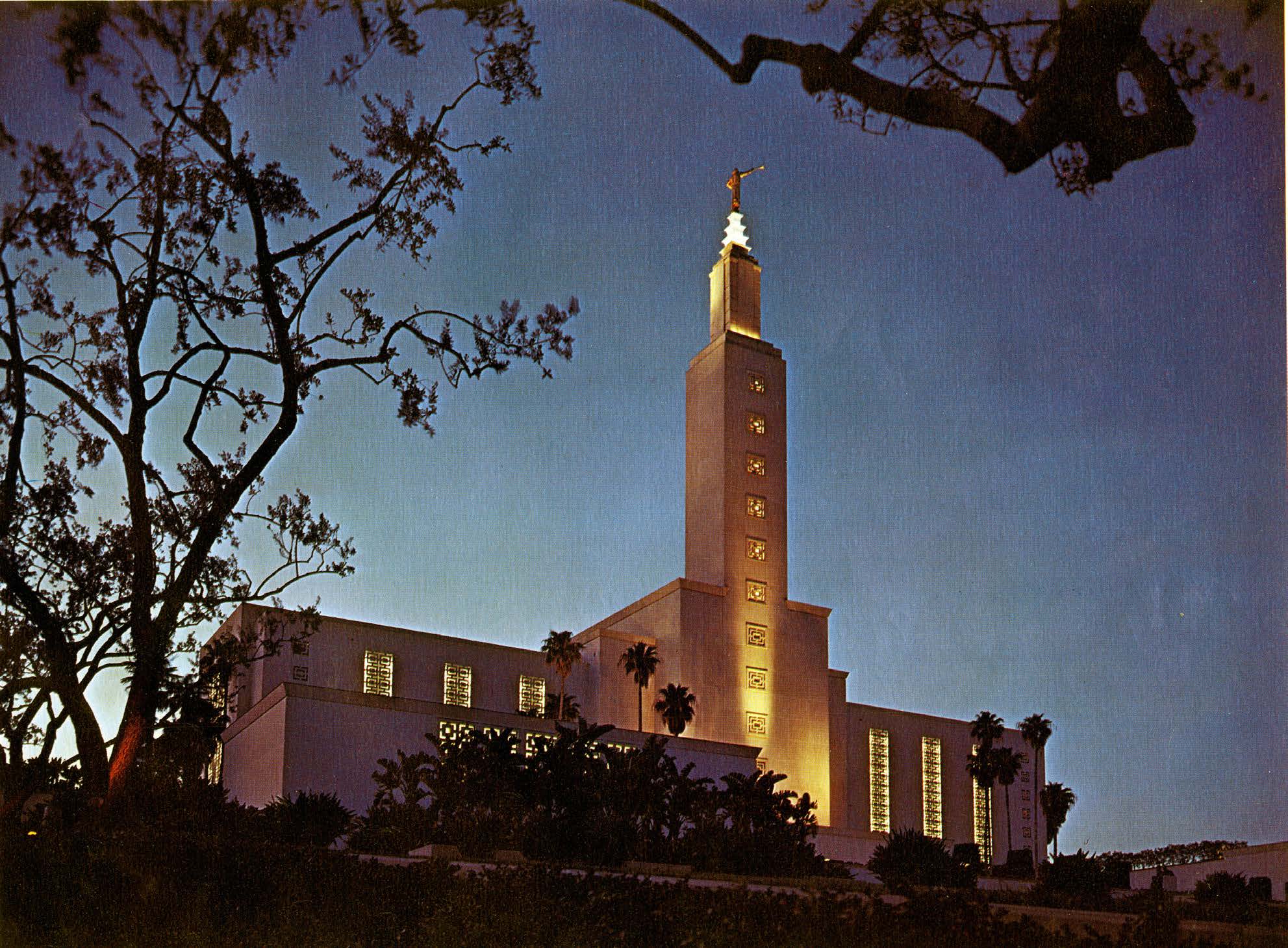 The Los Angeles Temple at night. (Scrapbook)
The Los Angeles Temple at night. (Scrapbook)
Carolyn Allen many years later recalled her experience as a teenager at the dedication. While she and a friend were standing in line outside “clutching our ‘special recommends,’” one usher told them all the rooms were filled. Just then, another usher came and told them there were two seats available. “We followed the usher as he led us past the full room outfitted with closed circuit TVs to the elevator. He said the seats were in the Assembly Hall!” They found themselves seated on the front row. “There in front of us were all the General Authorities dressed in white. Dignified President McKay with his beautiful, thick white hair, conducted the proceeding with strength and vigor. Time has dimmed the memory of the words spoken that day, but not the exhilaration and burning within my bosom as we participated in the ‘Hosanna Shout’ (my handkerchief is carefully preserved in a Book of Remembrance). My friend and I hugged each another, not wanting the moment to end.”[84]
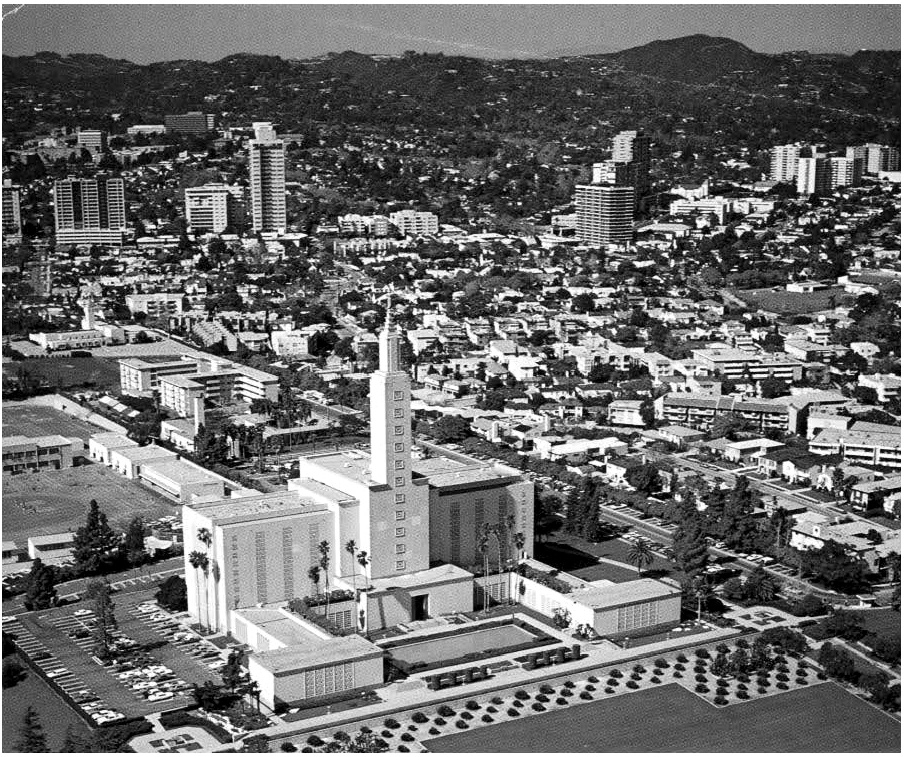
A young boy, John W. “Jack” Welch, from Whittier, California, was one of those who attended the temple’s dedication. With his mother, father, and older sister, he viewed the proceedings in the creation room. Jack remembers the long wait for the proceedings to begin, but spent the time reading a book that his mother had brought for him; it was about Joseph Smith and was entitled From Plowboy to Prophet. He was fascinated with the murals on the room’s surrounding walls, with swirling colors, oranges and reds, depicting the state of things before matter was organized and became our earth. After the dedication, he and many others stood in line to shake the hand of President David O. McKay as he came out of the temple appearing holy with his snowy hair and in his white suit. That gracious moment and impressive occasion was memorable for all who attended the dedication, both young and old, leaving a lasting impression that would enrich many subsequent personal and family occasions in the Los Angeles Temple.[85]
Local newspapers gave extensive and favorable coverage to the dedication. On Monday morning, the front page of the Los Angeles Times proclaimed, “Twelve Thousand Dedicate L.A. Mormon Temple.” The article affirmed: “A temple was dedicated to the Lord yesterday. It is the greatest ever built by one of the fastest growing churches in America.” The Los Angeles Examiner also devoted multiple columns to the story, labeling the dedication as one of the Church’s “most impressive spiritual achievements.” Both papers illustrated their stories with a large photo of President and Sister McKay and another showing the crowds on the temple grounds.[86]
One Church member, Helen Kimball Orgill, expressed her feelings about the new temple in poetic form.
A Temple in Los Angeles
Sing aloud, ye souls immortal,
From your dwelling mid the stars,
Waiting for a temple ordinance,
To be freed from prison bars!
Heaven’s veil seems near to bursting,
You have prayed and waited, too,
And your God in mercy harkens,
All the praise to him is due.
On the shores, of the Pacific,
Where the palm trees meet the sea,
Lo behold another temple,
Looms aloft majestically!
Here the remnant seed of Laman
Will join Ephraim’s mighty throng,
To be Saviors on Mt. Zion,
In God’s kingdom they belong.
Then O sing, ye souls immortal,
For the work will roll along,
Let hosannas rend the heavens,
Praising God in joyful song![87]
Arthur Wallace, who had become the Los Angeles Stake Young Men’s president, reflected that the dedication of the temple changed the spiritual outlook of the Saints: “Prior to the building of the temple, the Church in the Los Angeles area was rather social in nature. Many gala affairs were held and it was fun to be a member of The Church of Jesus Christ of Latter-Day Saints in the Los Angeles area.” The Wilshire Ward Chapel was attractive and many young couples chose to get married there “rather than traveling hundreds and hundreds of miles to go to a temple. After the Saints joined together and sacrificed to build the Los Angeles Temple, a special unity developed between Church members as the temple became the center of their lives. The temple changed the Saints in the area to a temple going people. Their priorities became different.”[88]
With their new temple dedicated, the Southern California Saints could look forward to the spiritual growth that would come from the service they would give in the Lord’s holy house.
Notes
[1] Chad L. Orton, More Faith Than Fear: The Los Angeles Stake Story (Salt Lake City, Bookcraft, 1987), 186.
[2] “Pres. Raymond to Address Class,” Church News, March 12, 1955, 10; “Pres. Raymond Addresses Seminary Class,” Church News, March 26, 1955, 10.
[3] Edward O. Anderson, “The Los Angeles Temple,” January 19, 1956, typescript, Church History Library, MS 757, 4.
[4] “L.A. Examiner Puts Out Page on ‘Mormon Temple,’” Church News, July 11, 1953, 12.
[5] Joseph Lundstrom, “Trade Magazine Describes Temple,” Church News, October 24, 1953, 6.
[6] “Electricity’s Role in the New Los Angeles Mormon Temple,” Electrical West 116, no. 1 (January 1956): 68.
[7] Edward O. Anderson, “The Los Angeles Temple,” Improvement Era, November 1955, 807.
[8] “Los Angeles Temple Certain to Prove Missionary Force,” Church News, January 9, 1954, 4.
[9] “California Mission: Elder McConkie Reports Successes,” Church News, May 1, 1954, 3.
[10] “Elder Frederick S. Williams Named President of L.A. Temple Mission,” Church News, January 1, 1955, 2.
[11] “Benjamin L. Bowring Named President; Elder Steed Chosen,” Church News, December 3, 1955, 2, 8; Ned Redding, “L.A. Temple Mission Presidency Complete,” Church News, January 14, 1956, 8.
[12] Joseph Lundstrom, “New Mecca for Tourists: Thousands Visit L.A. Temple Grounds,” Church News, July 30, 1955, 4.
[13] “What Visitors Are Saying about Temple,” California Intermountain News, September 27, 1955, 39.
[14] Anderson, “Los Angeles Temple,” November 1955, 807.
[15] See “What Visitors Are Saying, 39.
[16] Henry A. Smith, “L.A. Temple Construction in Final Stages,” Church News, July 16, 1955, 6–7.
[17] “Painting Completed” and “Bronze Oxen Placed in L.A. Temple Font,” Church News, November 12, 1955, 1, 6.
[18] “Last Mural in L.A. Temple Is Completed,” Church News, November 12, 1955, 6.
[19] Ned Redding, “Los Angeles Temple: First Meeting Scheduled on November 25,” Church News, November 19, 1955, 6.
[20] Ned Redding, “Los Angeles Temple Fund: Campaign Launched to Pay Off Final Sum,” Church News, December 10, 1955, 8.
[21] Frederick S. Williams, “Temple Anniversary: L.A. Temple Dedicated 15 Years Ago Today By Pres. David O. McKay,” California Intermountain News, March 11, 1971, 9–10.
[22] Doyle L. Green, “Multitudes Visit Los Angeles Temple,” Improvement Era, March 1956, 159.
[23] “Governor Knight and Wife See New Mormon Temple,” Los Angeles Times, December 14, 1955.
[24] Ned Redding, “3,000 Make Tour of New Structure,” Church News, December 24, 1955, 5; “New Los Angeles Temple Visited by Mesa Youth,” Church News, December 31, 1955, 3.
[25] “L.A. Bureau Will Close on Sundays,” Church News, December 10, 1955, 8.
[26] Quoted in Green, “Multitudes Visit Los Angeles Temple,” 159, 187.
[27] “The Temple of the Five Rooms,” Time, January 16, 1956, 72.
[28] Redding, “3,000 Make Tour,” 5, 10.
[29] Redding, “3,000 Make Tour,” 10.
[30] “President McKay Back from Temple Visit,” Church News, January 21, 1956, 2; “18,452 Visit L.A. Temple in Single Day,” Church News, January 28, 1956, 2.
[31] Ned Redding, “Rains Fail to Stop Parade of Visitors,” Church News, February 4, 1956, 3.
[32] “Rag Rugs for Temple Given President Bowring,” Church News, February 11, 1956, 2.
[33] “1,500 Teachers Make Tour of L.A. Temple,” Church News, December 31, 1955, 7.
[34] “Legal Officials among Guests on Temple Tour,” Church News, January 21, 1956, 2.
[35] “39 Deaf Members Make Visit to L.A. Temple,” Church News, February 4, 1956, 7.
[36] Ned Redding, “Visiting Halted As 650,000 See Edifice,” Church News, February 18, 1956, 3.
[37] Gregory A. Prince and Wm. Robert Wright, David O. McKay and the Rise of Modern Mormonism (Salt Lake City: University of Utah Press, 2005), 259.
[38] “Pres. McKay Back from Temple Visit,” Church News, January 21, 1956, 2.
[39] California Intermountain News, March 8, 1956, 26.
[40] Redding, “Rains Fail to Stop Parade of Visitors,” 3, 11.
[41] Ned Redding, “600,000 Visitors to See New Edifice,” Church News, February 11, 1956, 11; Green, “Multitudes Visit Los Angeles Temple,” 159.
[42] Redding, “600,000 Visitors,” 2, 11.
[43] Redding, “600,000 Visitors,” 2.
[44] Quoted in Green, “Multitudes Visit Los Angeles Temple” 158–59.
[45] Redding, “Visiting Halted as 650,000 See Edifice,” 3.
[46] Ora Pate Stewart, “From Where I Stood,” California Intermountain News, March 8, 1956, 37,40.
[47] Ruth I. Deveraux, “In the Garden Room,” California Intermountain News, March 8, 1965, 39.
[48] California Intermountain News, September 27, 1955, 101.
[49] Redding, “Visiting Halted,” Church News, February 18, 1956, 1, 3.
[50] “662,361 Visitors Tour Temple Prior to Dedication Services,” Church News, March 10, 1956, 2.
[51] “California Provides Most of Visitors during Preview,” Church News, September 8, 1956, 13.
[52] Dan L. Thrapp, “Mormon Temple Dedication Set,” Los Angeles Times, March 5, 1956, 1, 3ff.
[53] “New Beacon,” Ventura Star Free Press, March 3, 1956; “Mormon Temple at Night,” Anaheim Bulletin, March 3, 1956.
[54] Omar Garrison, “Church Head to Dedicate Mormon Temple Here,” Mirror-News, March 1, 1956.
[55] “Close Mormon Ties Seen with New L.A. Temple,” Los Angeles Times, March 8, 1956.
[56] “Video Show Features L.A. Temple,” Church News, February 25, 1956, 3; Ned Redding, “Television Program Features Imposing Los Angeles Temple,” Church News, March 10, 1956, 4.
[57] “Shampooing Restores Carpeting,” California Intermountain News, March 8, 1956, 8; “Temple Carpeting Stands Up under Traffic of Visitors,” Church News, March 3, 1956, 5.
[58] Carolyn Sessions Allen, “View from the Front Row: Remembering the Day the L.A. Temple Was Dedicated,” Latter-day Sentinel, March 1, 1986, 2.
[59] “How Members May Arrange to Attend Temple Dedication,” Church News, February 18, 1956.
[60] “LDS Executives Leave to Direct Temple Service,” Salt Lake Tribune, March 9, 1956.
[61] “Thousands Converge on Los Angeles for Temple Services,” Church News, March 10, 1956, 2.
[62] “Church Leaders Leave for L.A.,” Deseret News, March 9, 1956.
[63] “Temple District Completes Finance Drive,” Church News, March 10, 1956, 4; William B. Smart, “All Church Rejoices in Dedication of Los Angeles Temple,” Church News, March 17, 1956, 2.
[64] “Governor Knight, Mayor Poulson Send Greetings,” Church News, March 10, 1956, 2; Improvement Era, April 1956, 229–30; for the complete text of these congratulatory communications, see appendix I.
[65] “Much Planning behind Dedication of Temple,” Deseret News, March 10, 1956.
[66] Doyle L. Green, “Los Angeles Temple Dedication,” Improvement Era, April 1956, 228–32.
[67] William B. Smart, “All Church Rejoices in Dedication of Los Angeles Temple,” Church News, March 17, 1956, 2.
[68] “We Are Especially Blessed: Temple Offers Incomparable Blessings, Grave Obligations,” Church News, March 17, 1956, 4, 9.
[69] “The Last Dispensation: Building of Temples Ever a Primary Endeavor of Church,” Church News, March 17, 1956, 5, 8; for the complete text of the First Presidency’s messages, see appendix J.
[70] William B. Smart, “All Church Rejoices in Dedication of Los Angeles Temple,” Church News, March 17, 1956, 2.
[71] Sheryl Stardup Worsley, interview, January 2017, notes in possession of author.
[72] “Sunday Afternoon: Pres. Smith, Elders Lee, Benson Tell Temple’s Purposes,” Church News, March 17, 1956, 6.
[73] “Monday Morning: Elder Kimball Tells Early Temples’ Fate,” Church News, March 17, 1956, 6.
[74] “Monday Afternoon: Pres. McKay Stresses Closeness of Man to Heavenly Beings,” Church News, March 17, 1956, 7.
[75] Darlene H. Andrus, interview by Marilyn Mills, March 20, 2017, recording in possession of the author.
[76] “Tuesday Morning: Blessings of Temple Marriages Related,” Church News, March 17, 1956, 7–8.
[77] “Tuesday Afternoon: Best of Everything in New Temple, Says Pres. McKay,” Church News, March 17, 1956, 8.
[78] “Wednesday Morning, Afternoon: Final Sessions Hear Burning Testimony by President McKay,” Church News, March 17, 1956, 9.
[79] S. Dilworth Young, “Dedication,” Improvement Era, June 1956, 438.
[80] “Dedicatory Prayer—Los Angeles Temple,” Improvement Era, April 1956, 225–27; for the complete text of the prayer, see appendix K.
[81] “Hosanna Anthem,” in The Choirbook (Salt Lake City: The Church of Jesus Christ of Latter-day Saints, 1995), 69–71; duplicated phrases have not been repeated.
[82] Green, “Los Angeles Temple Dedication,” 232.
[83] Quoted in L. Brent Goates, Harold B. Lee: Prophet and Seer (Salt Lake City: Deseret Book, 1985), 324. Goates refers to an “alleged dream or revelation” about his future service, which Elder Lee was supposed to have received during the Los Angeles Temple dedication and suggests that the truth of this story is told simply in Elder Lee’s diary entry quoted here.
[84] Allen, “View from the Front Row,” 2.
[85] John. W. Welch, email, September 6, 2017.
[86] Green, “Los Angeles Temple Dedication,” 232.
[87] Helen Kimball Orgill, “A Temple in Los Angeles,” Improvement Era, November 1955, 866.
[88] Arthur and Elna Wallace, Stories Related to the Construction of Los Angeles Temple, Los Angeles Temple Scrapbook.